Text
Championship Surfer - 2000
The next game I dropped into is a pretty big leap forward, Championship Surfer on the Dreamcast, released in November 2000. I didn’t have a DC when they were first released (I was one of the people responsible for its failure, knowing about it but deciding to wait for the PS2), but I’ve had this one for a few years and I have to say, I like the Dreamcast.

This is one of the first games I bought for the system when I got it, and like most people probably did (based on the ratings this game got when it was new), I tried it for a little bit and then moved on. Once I decided to write the one surfing videogame series to rule them all, I started putting some serious time into the game.

It does look pretty good - water is something videogames have had trouble with from the beginning (same thing with hair). The waves in this game have direction, and all have size and shape variations. Honestly the more I played it the more I was impressed with whatever engine was generating the waves.
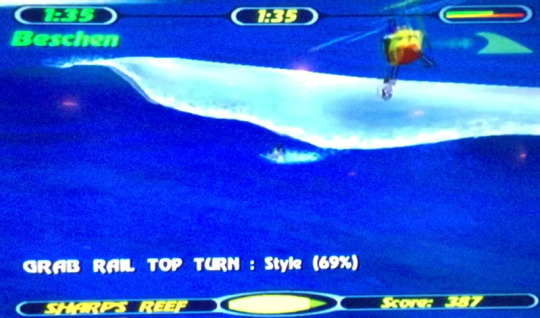
This level, for example has a wave that breaks early, so you have no choice but to start your ride in the green room. Try to ride up too high on this wave and you fall, just like the steep parts of overhead waves like this.
Waves are the part of surfing that most people don’t talk about much, other than noting when one is especially big. Reading how they break and which ones are ridable is probably the hardest part of surfing with the steepest learning curve. Of course there are breaks where the waves form and break very consistently, but since these are easier to read, most of these places are very crowded. I’ve spent a lot of time floating around in the mush at beach breaks, trying to figure out what is going on. It was a tough early lesson for me in surfing - no two waves are ever the same (duh), but of course I was trying to be methodical about improving my skill. It took more than a year for me to realize -- a lot of the time you can predict what a wave is going to do, but a lot of the time you can’t. Sometimes they break early, sometimes they crumble down, sometimes they close out, and sometimes they make it almost all the way to shore before breaking -- and this can be at the same place at the same time over the course of 15 minutes or so.

At any rate, this game clearly had a surfer talking to the guys programming the waves. They are all catchable, but some come in early, others late. Some of them have flat spots, and some of them are very violent, sucking you up on top of the falls if you get too close, or throwing you out in front of the wave if you are in the wrong spot. Some of them have a stepwise drop, just like some of the weirdo waves out in the world.
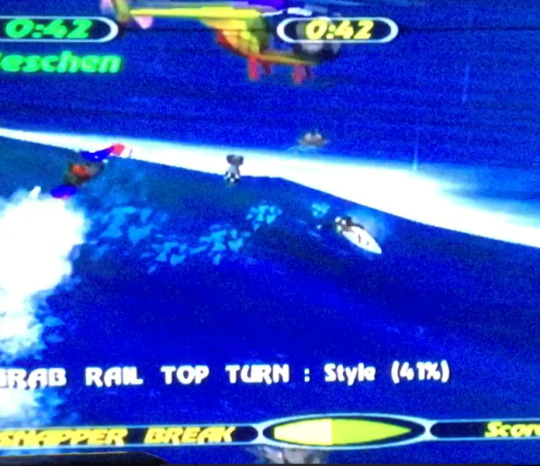
So the waves are impressive, even if the water effects are pretty dated. The character models are pretty limited, so they gave everyone different colored wet suits to differentiate them. Learning how to play this game took a while, and I have to say I really had to apply myself to getting the controls down. I play(ed) and play a lot of Tony Hawk, so figuring out tricks and scoring is not a new thing for me -- I did finally get proficient, but it seemed like every time I unlocked a new beach, there was a new learning curve to climb. The pic above is the first example. Not enough that you have to catch the wave and start carving it without wiping out or falling off the back, the arcade mode puts all kinds of crap in the way to keep things from getting repetitive (it still does). Here you see floating naval mines (one of those will take out more than half your board life -- the surfboard icon at the bottom of the screen is the ‘life meter’), a helicopter that tracks you and drops bombs, and a super rude guy on a jet ski. To this you can add buoys (they look like beach balls), surf photogs with cameras (nice touch) and SHARKS!
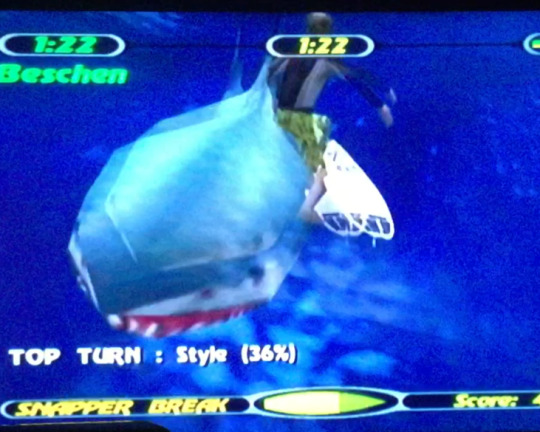
Whether or not you are the victim of a shark attack is really irrelevant, they are like huge logs in the surf and are a much bigger hazard because of their size. There is a very cool attack animation to these guys, and they will track you around the wave face (they kinda pivot, but they can’t really chase you much). Here’s another look that is not so close.

The fact that I am still on my board in this picture must mean I jumped the shark! They don’t submerge enough to be able to surf over them, but if that is Shane Beschen (and assume he’s somewhere between 5′6″ and 6′ - that is at least a 12 footer. HUGE shark. One addition I have to take exception to is the dolphin hazard.

They burst up out of the surf and twirl a little bit. Easy enough to dodge, but dolphins? I’ve shared waves with dolphins in real life - they hang out with surfers. They even let their babies get close to surfers as the little guys are curious. They would not be caught in this anti-surfer chicanery. So, one has to suspend belief a bit.
If you look at the scoring, I think the idea here was that tricks are somewhat limited (there are supposed to be 40 tricks, but I assume that is including all the combos), so the game awards you points on how well you executed the trick? I’m not sure if this is how real surfing competitions are held, but it seems a bit arbitrary here.

This is the overhead view that you get right before you are given control - the white thing in the middle is your surfer. Notice that the clock has already started ticking down, and I’m still there waiting for the wave. All those white smeary things to the right are obstacles, lined up to get in your way while you try to shred. You can see the helicopter on the far left just starting to bank over so it can hover over the wave face and try to blow you up.

All this crap shows up in Arcade mode, and once it started getting stupid (the jet ski guy is like a missile trying to run you over) I thought - ‘Hey! I bet I can get that guy to run into the mines and clear a path, or bait him into one of the bombs from the helicopter, or at least trick him into getting wrecked by the wave.’ And then I tried all this and found my biggest issue with the game: Everything in the surf is not only not impacted by what the wave does, they do not interact with each other.

So the jet ski will go right through a mine (or a shark, or a photographer), and both remain hazards. Bombs from the helicopter make these huge explosions but they won’t detonate mines. There is a very intricate set of animations where the photographers dive under the wave right before it crashes, but their fins stay above the water line so you will still wreck if you hit them. The Shark, the mines and the jet ski treat the crashing wave just like a hump in that they will change elevation (and will get sucked up to the crest), but the only thing that can go over the falls is your surfer. Above you can see the jet ski actually turning on the face of the wave while upside-down to keep coming after me.

You can see the bomb explosion here, but that gray blob in the white is actually a shark I just jumped over. In the actual ocean, no shark is ever going to get this close to the crest of a wave and if they did, they would get rolled. In Championship Surfer, the sharks are immortal, and also magic? One other item that makes things difficult is the camera seems to change angles at random, and the controls get tighter the close you are zoomed in - great for setting up tricks but horrible for trying to not get blown up -- you can’t see any of the obstacles until your are running into them in several of the angles.

Each wave starts with a wide angle view, which is great for looking at what is coming up, but this means you have to catch your first wave before you adjust the camera - every single time. Even after this, the angle you choose may be discarded by the game, or maybe not. I have no idea of the logic behind the camera moving around.
One nice touch is the idle screen, which is great product placement for O’Neill.
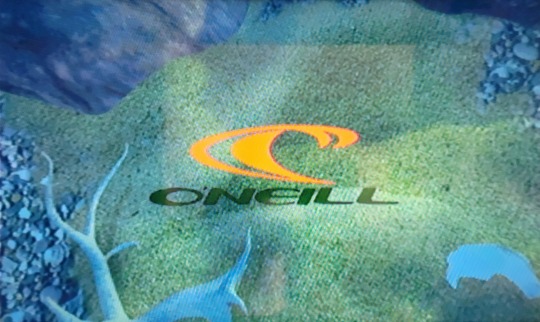
I have a couple of O’Neill wetsuits and some other neoprene goodness from them. High quality, and from what I have read this game was originally announced as ‘Billabong Pro Surfing’, but something must have gone wrong with the ‘bong because O’Neill is kinda tacked on here.
You can pick from 8 different surfers and a bunch of different boards, but I didn’t really notice much of a difference between any of them. You can also pick from several different weather conditions - a nice touch in that you can select Hurricane - the water is black, it is pouring rain and the waves are super choppy.

There are several modes of play, you can compete in a tournament or do trick attack, and there is even a rumble mode, where you try to knock other surfers out in single combat on the waves! Didn’t expect that. In tournament mode, I experienced the only time I will beat John John Florence in anything (he’s just a kid, but he is in this game) As far as unlockables and secrets, the only real way to progress is to complete challenges in Arcade mode, which has Beginner, Amateur and Pro. You unlock more beaches with every success, culminating in Dead Man’s, which took a while to beat. Once you do this, you get a Polarman who looks like Ice man in the arctic. He surfs, but other than trying for a high score you can’t do much.
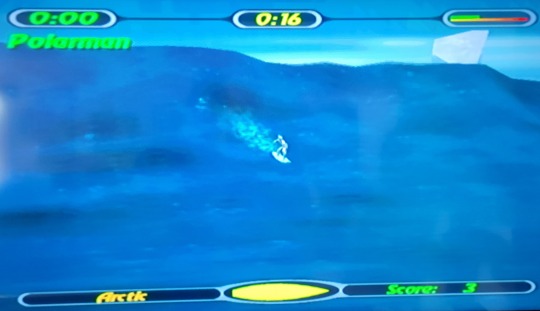
There are a bunch of cool fmv files you can watch, but a lot like the Tony Hawk games, you can do a lot more in the game than real life, so while they are impressive, they don’t stack up so well with unreality.
In conclusion, I have some conclusions:
1) The reviewers of this game 20-some years ago probably didn’t play the game very much. They were also correct in rating this game low, as the learning curve doesn’t have much of a payoff - so why make it so difficult?
2) Even though I have only reviewed 2 surfing games so far, this one is the clear top of the heap. Though it didn’t translate to success for this game (or any surfing games as far as I can tell), the wave behavior introduced in this game is pretty true to life in that there is a certain randomness to the waves. This is especially harrowing when you are very close to getting the required score in arcade mode, and the only wave it gives you feeds you right to the shark.
3) If the developers would have spent a bit more time on the collision mechanics with all the obstacles, the arcade mode would take on a new character. Man, I would have loved leading the jet ski guy into a mine and watching him explode (he points at you after he wrecks you, the nerve!). Somehow the helicopter can knock you off your board on the crest of the wave with its skids, but the jet ski flies right through it when you line them up?
First time in a while my thumbs hurt from playing a game so much. I had a good time with this, and I expect I’ll revisit it now and then just like THPS2, which is high praise.
0 notes
Text
Turning to Channel F
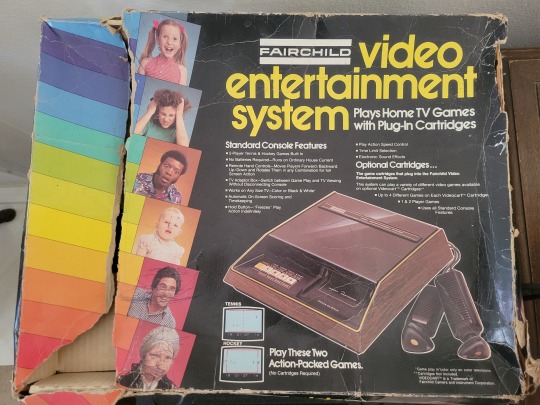
Today’s detour from the vagaries of Surfing video games (still playing, but had a change of plans) involves a piece of gaming history. This fine piece of wood grain adorned set top goodness is from November 1976, released by Fairchild. This is one of the early ones, as it was renamed the “Channel F” (F is for fun) when Atari launched their Video Computer System a little less than a year later. The key is in this feature:
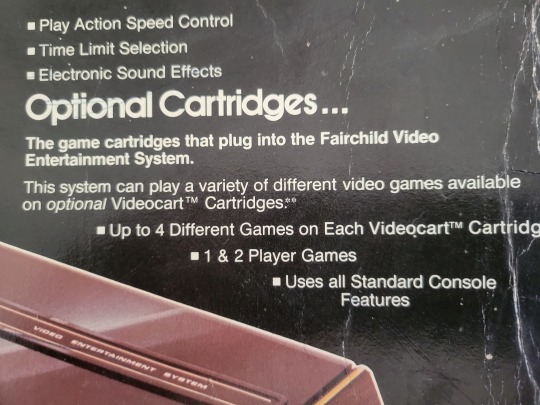
The Fairchild VES was the first system to use ROM cartridges (earlier consoles had enabled folks to use ‘games’ that were really just sets of jumpers inserted into the main console to change into another of the 100 versions of PONG that most of them played). This is notable, as the Chief Engineer for Fairchild at the time was Gerald Lawson (much more info at this link: https://www.google.com/doodles/gerald-jerry-lawsons-82nd-birthday ).
Fairchild only sold about 350,000 units before they called it quits and sold the IP off. Their main product was microprocessors, so this was a bit of a flyer for them. Given the way things exploded for Atari, they came very close to hitting the big time -- anyhoo, the point is not very many of these out in the wild, and most of them need to be acquired as a ‘parts only’ purchase. I suspect this is because the power supplies for most of these (which is hard wired to the console) go bad, or people have no idea how to hook it up to a modern TV to test it.
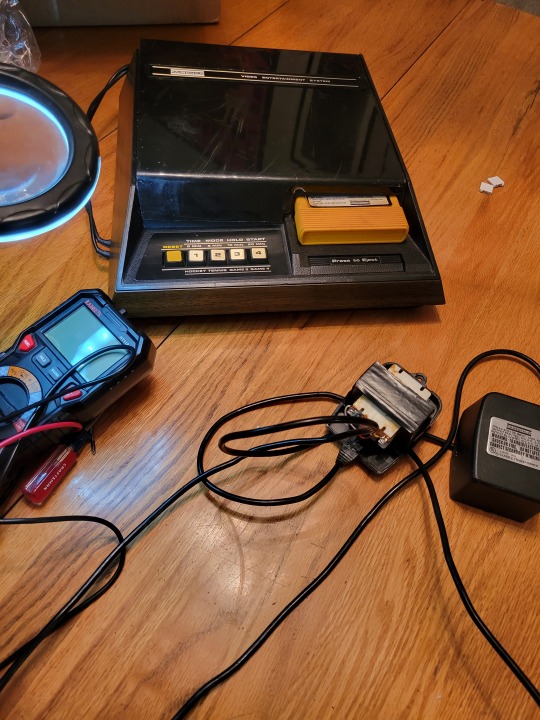
The one I bought was in such a state. Overall it looked pretty good for a 47-year old console, but of course no response when I powered it on. Checking the power block was the first thing I suspected, and sure enough, the output voltages of the power supply where no where near where they were supposed to be, Looking at the block itself - it has 2 different AC inlets....!?
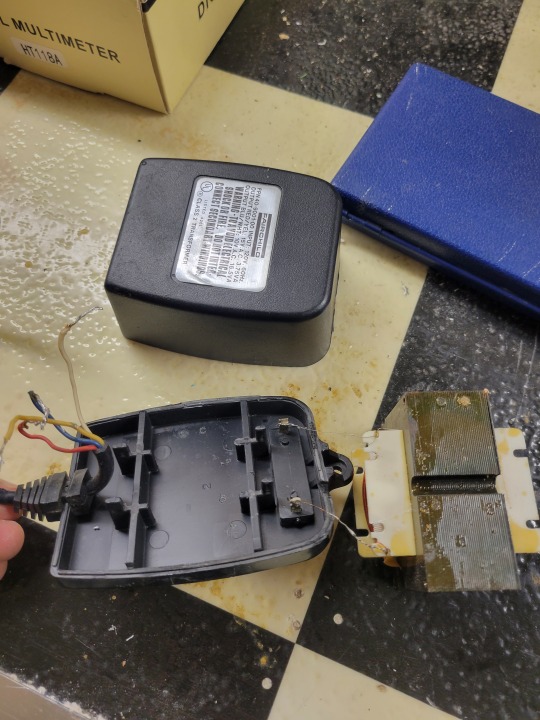
The nice folks at the AtariAge forums have a few threads related to the Fairchild and it’s other worldly counterparts. Sure enough - 15VAC 200mA is one input, and the other is 10VAC 1A. Having no idea how to try and Frankenstein this coil back to life, I went in search of adequate AC-AC adapters to be able to get the unit to power on. Reading through the info out on the net, and looking through the schematics, there are rectifiers and capacitors/voltage regulators that step these two inputs down to 12V and 5 V DC. To be able to connect my new power supplies I needed to open it up - so here we go...!

The good news is, everything looked clean. Even the caps looked pretty good, which was surprising as I bet they run a bit hot with all the current being fed into the unit. Look at all that metal shielding! it looks like FCC regs were written with a severe concern over RF interference? Who knows. All I know is that there is the plastic case, and then an entire metal case under the plastic case shrouding all the electronics. Even the power supply is just a simple MOLEX connection through the shielding to another MOLEX inside. Huh. I did manage to locate 2 AC-AC adapters that looked like they would do the trick.
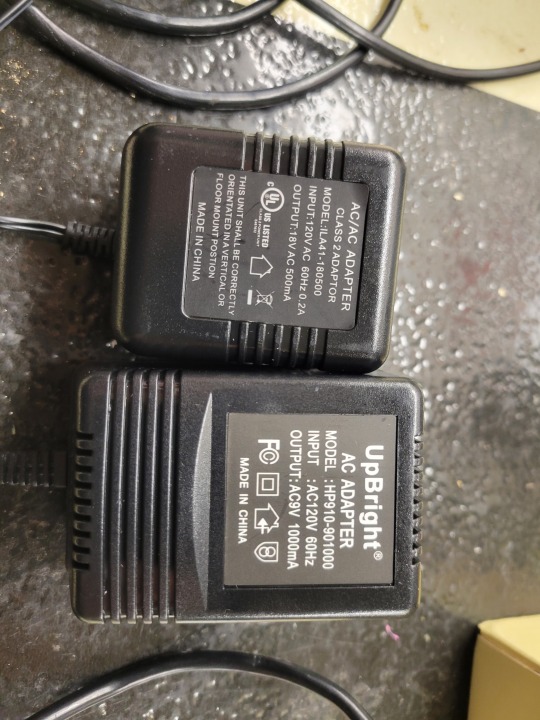
So I wired them up to the unit and powered on - I knew from the Atari Age geniuses that there is a small red power indicating LED on the board (under the cartridge port and also under the shielding over the cartridge port, so I have no idea who it is for) that indicates the 5V power rail is active. I verified this was active:
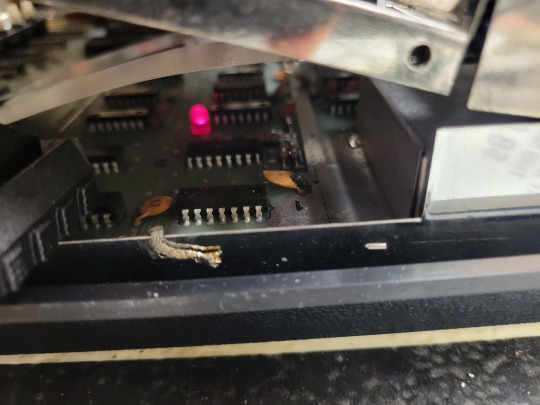
And was thinking I might be done! Too bad - but close - my video output was the green screen.

Before I went too much further, I wanted to chase down the power issues. I ended up just disconnecting the MOLEX outside the shielding, and just wiring power right to the wires on the board (power readings on the inlet power cord were all over the place, so I suspect there may have been some wire continuity issues there).
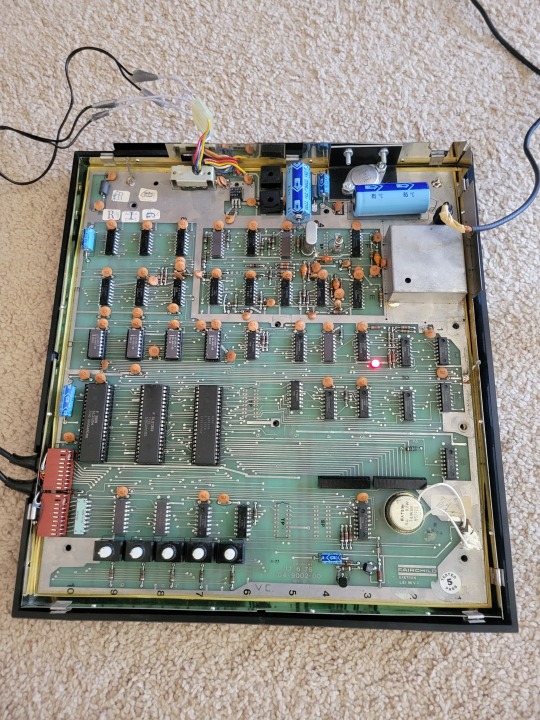
Once I got to this point, I just connected the video out and holy cow! we’re in business.
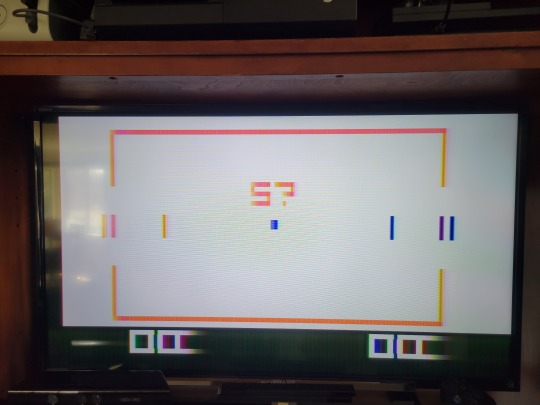
PONG all day and night if we want. Plus a bunch of other games, some of which are terrible but most of which are charming. In a sense, Jerry Lawson taught my sons not to hit on 16 playing black jack. Here’s one of the games (Space War) in action.

One thing that is not great, which was changed for the Channel F II was the sound. For this unit, it comes from the console, and has no volume control. Seeing that most of the videogaming that would have been done on this machine would have been early or late in the day when your parents weren’t using the TV, this one factor may have limited the success. Being able to turn the Atari down low so you could still hear the bleeps and bloops but mom and dad could keep sleeping was key to playing time back in the day.
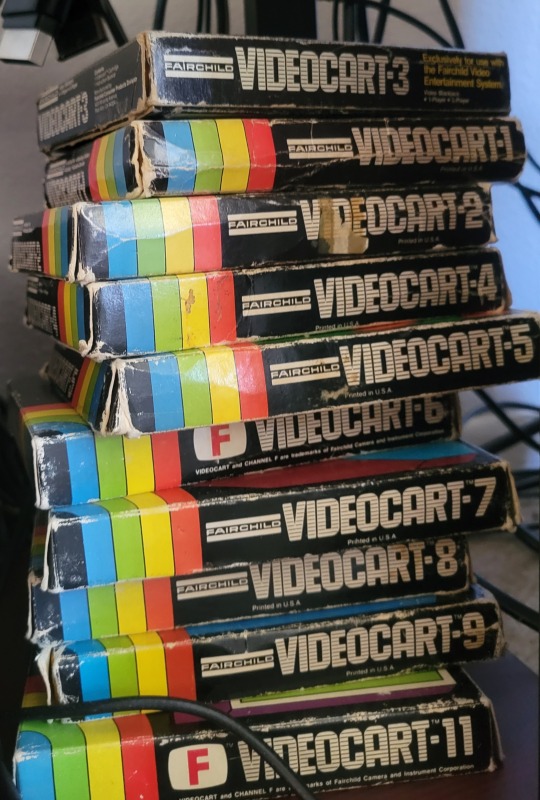
One other item to note is the distinctive but very forward thinking design on the controllers. The knob on the top does all the work -- button presses are pulling up and pushing down. The stick movement is active in all directions, and you can also rotate right and left. It is not very intuitive, but once you play with it for a while the games feel pretty natural. Thinking about how these compare to the Atari joysticks, they have a lot more potential.
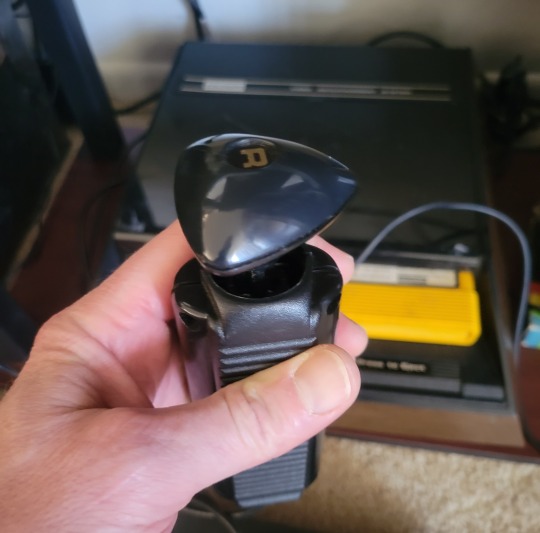
All in all not too much trouble, and a fun little project. Very cool that this old beast is now in working order. In retrospect, Fairchild had the right idea, but Atari took it and ran! One has to imagine that if the Channel F had been able to get space invaders, they would likely have done just as well. As it is, they are a bit of a footnote, but I have the footnote running in my house!
Fun Fact: The dimensions of the Channel F cartridges were set to approximate those of 8-track tapes, which were a thing at the time. They were then colored bright orange/yellow so people wouldn’t mistake Burt Bacharach for a Math Quiz Videocart.
1 note
·
View note
Text
California Games - 1987 (1991)
For those not in the know, part of the reason for the hiatus here was a relocation of the entire (un)thinking family to a state that has a coastline. After having lived inland for my entire life, this was a new thing and having the ocean a 20 minute drive away meant a whole new world at our fingertips. I really knew almost nothing about the shore except that in theory, one could ride the waves if one so desired. So, at the fresh young age of 47 I decided to take up surfing.
Now, I was a skier and also snowboarded quite a bit during my time in Colorado so naturally I assumed there was some similarity between the two. I mean technically both are standing on a board sliding over water, right? Well, yes - however - the time spent actually on the board while surfing as compared to the time spent trying to get into that position meant that there were a whole new set of skills I had to learn.
It turns out that the ocean does a lot of things all at once, and catching just the right part of it at the right time is not easy. I booked a lesson with a local surf school, which turned into me booking several lessons with them (zumasurfandswim.com if you are interested) - we met in February, which one would think is a bit cold - and it was! But, the Pacific Ocean is almost always cold, so you have to wear a wetsuit anyway. Despite what all my coworkers (even the surfers) were telling me, I did get up on my feet that first day, wobbly and awkward. I was on a giant foam board that made things easier, but nothing about surfing is easy.
Which bring us to our first offering - California Games from Epyx.

As far as I can tell, this is the first instance of a commercial surfing game, originally released for the Commodore 64 in 1987, but ported to the Sega Genesis, which is the version I played. The box art pretty much says it all:
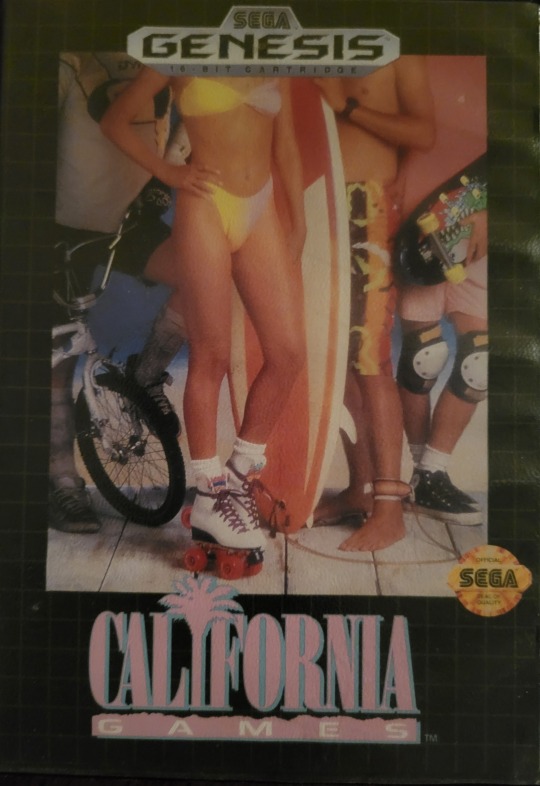
Basically, if we aren’t passing extremely punitive laws against the oil and gas industry, everyone out here is either skateboarding on a halfpipe, riding BMX, roller skating in a bikini, surfing or...(and I note this is too lame to make the box picture) playing hackey sack by the Golden Gate bridge. That is really all we do, so the game is more of a documentary than action sports.
Surfing is one of the 5 minigames, and the player (I think up to 10 players if you have 9 friends you can rope into it) can choose to compete in them all or just a single event. Since we focused on the the all-important category of surfing video games, I stuck with that.
One of the skills that people find hardest in surfing (present company included) is the pop-up. You have to paddle into a wave, and then at just the right time jump to your feet to stand up. If you are on a super mellow long wave in Hawai’i they will tell you to slowly climb up to your feet while keeping your balance. At shore breaks in Malibu, you have about 3 seconds to do this, and it represents one of the major challenges to surfing the breaks out here, especially for old people learning to surf.
None of this is reflected in California Games, where the player starts already in the wave, and the game pretty much waits for you to press a single button to pop up.
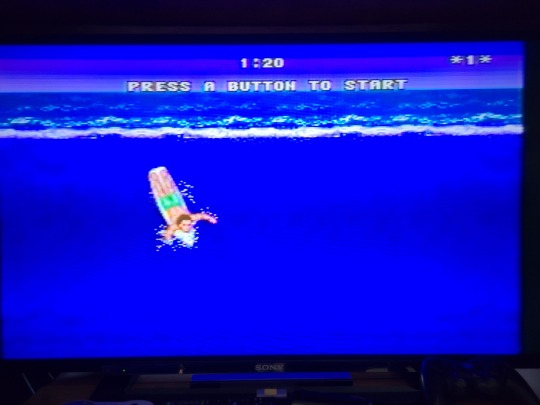
Once the player is standing, you immediately have to make the bottom turn (which is actually a thing), but other than that you can now play around on the wave. Points are granted for riding in the tube, collecting beach balls, doing “aerials” and “turns”.
It took a bit of messing around to get to it, but controlling your speed relative to the wave, as well as successfully jumping up and landing back in the wave are really just functions of the direction your board is facing. Diagonal moves generally mean you are going faster, and to land a jump, one has to position the board at the same relative angle you left the wave in. There are no grabs or tricks except just making the jump (which I might add is also the case with real surfing, at least where I am concerned).

For the longest time I couldn’t figure out how to get points for “turns”. I could never get far enough in front of the break to keep from wiping out if I tried going to the right (oh, I should mention - your surfer here is goofy footed and the wave is only a left, so that is all you get). I finally found that you can change into “Turbo” or “Light” mode with the surfing game, which means 1) everything is faster for turbo, so you can actually do a reverse 180 on a jump and hope to make it, and ‘light’ apparently means fast, as this is the only mode where I was able to do a cutback and then return to surfing the left. So there is that.
The music is the weirdest choice. The title screen is the rad driving 16 bit goodness one expects from California, but the surfing game sounds like...elevator music? Very low key and quiet.
The teenager’s reaction: “Is this it?” “Why didn’t they pick music that gets you excited or relates to surfing at some level in any way?” “Who is throwing those beach balls?”
All in all, not great, but this is 1991 by way of 1987 we’re talking about. I think I at least prefer the surfing to the hackey sack-ing.
0 notes
Photo
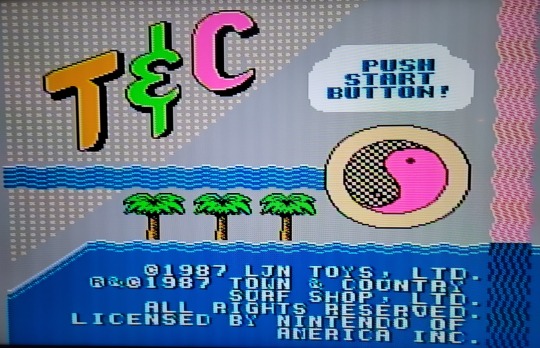
After many years in the wild, I am still (un)thinking man. Rather than ruminating on the ruin of the republic, I decided on the next best thing - a review of surfing video games through the years. Here we have Town & Country with one of (but not quite) the first offering from the late 80s. I have a dozen or so to get through (apparently there are more aspiring skateboarders than there are aspiring surfers) so check back for mildly amusing updates and epic (digital) wipeouts.
0 notes
Photo


Phase of the Moon Clock
Every Christmas I try and find a project I can make as a present. I made a bunch of little Christmas aliens with spaceships to give out to all my nieces and nephews, but I stumbled on this moon phase clock on thingiverse, and I knew I had to make it.
The original posting is here:
http://www.thingiverse.com/thing:1891599
With thingiverse, you never really know how much information you’ll be given, but after reading through the post and looking at the files, I decided to give it a try. I assumed that even if I couldn’t build it with all the functionality, I could write my own code to get the phases to work,
3D printing the parts was no issue, and I must say that having the Monstrbot working is very nice (build area is almost a cubic foot) for printing large items like the Moon hemisphere and the mount plate. I decided I wanted a bigger moon, so I just scaled up the meshes as needed.
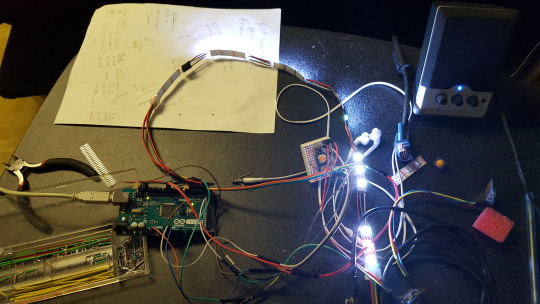
This is the first time I have worked with strip LEDs, and they are very cool. A little more complicated than the standard LED, but the are all RGB, so they can produce a lot of colors. The picture above shows the strip (note the wire splicing in between every 3 lights - this was needed to install these in side the moon so the phases will be distinct). At this point in the build, I was just troubleshooting the code -- note the arduino MEGA on the left. The actual unit uses an arduino nano - about 3K of space for the code (just about the same as my VIC-20 in 1982).
The guy who wrote this code helped me through troubleshooting - with so little memory to work with, I had to strip out some of the functionality (didn’t install a buzzer or a thermometer) so it would fit.

Here you can see the LEDs installed in the moon shell along with the stand before assembly. I also got the nano working. The code for this has a phase mode (meaning the moon accurately lights up to correspond to the appearance of the actual moon), an alarm mode, and six demo modes, which are all progressively more disco. My son loves lights, and now he has a bunch of different appearances to choose from.
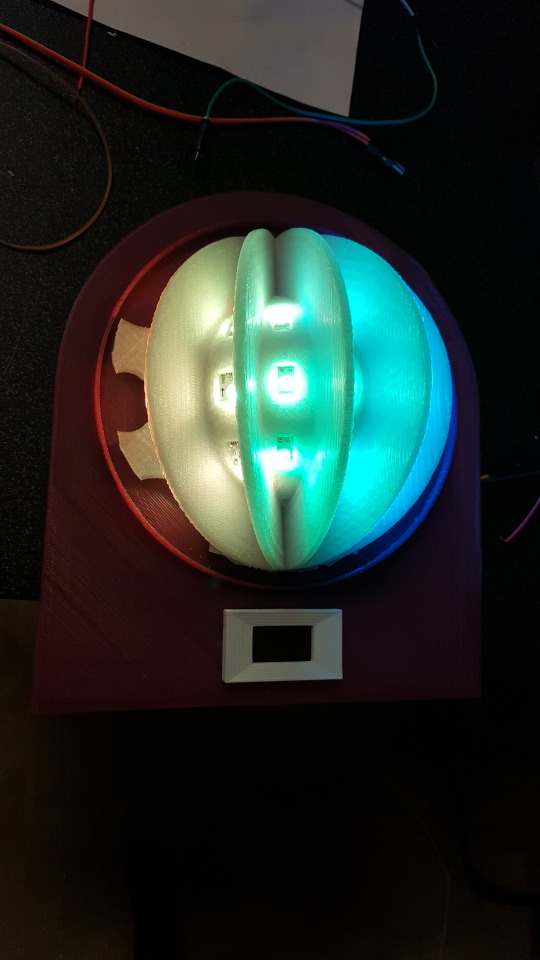
The LEDs were installed 3 lights per phase. This is what the interior of the moon looks like.
Because I printed this at a larger scale than what was posted, I had to add a bezel for the small OLED screen and a cover for the control board box (I know who will be pushing these buttons, so I made the cover pretty burly).
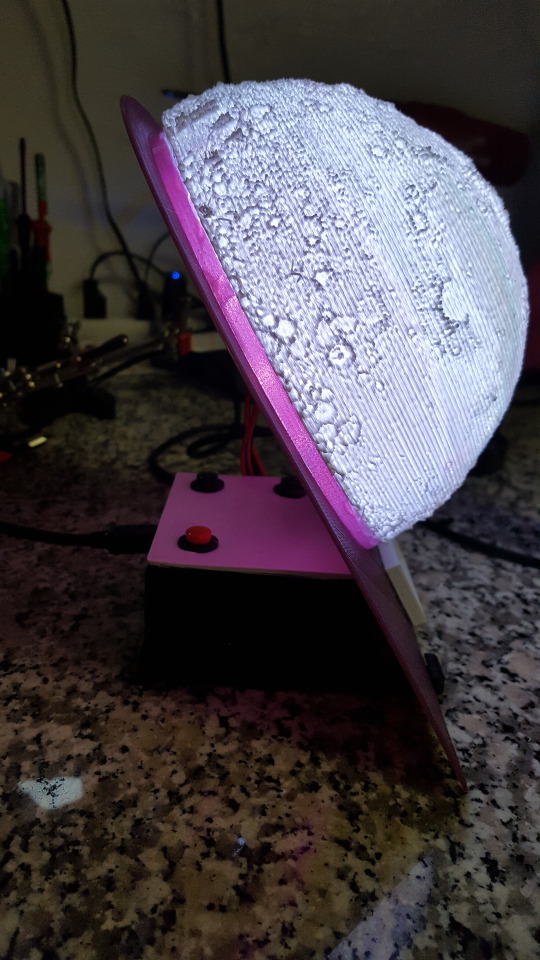
I hope he likes it. I’m pretty sure he will.
0 notes
Photo
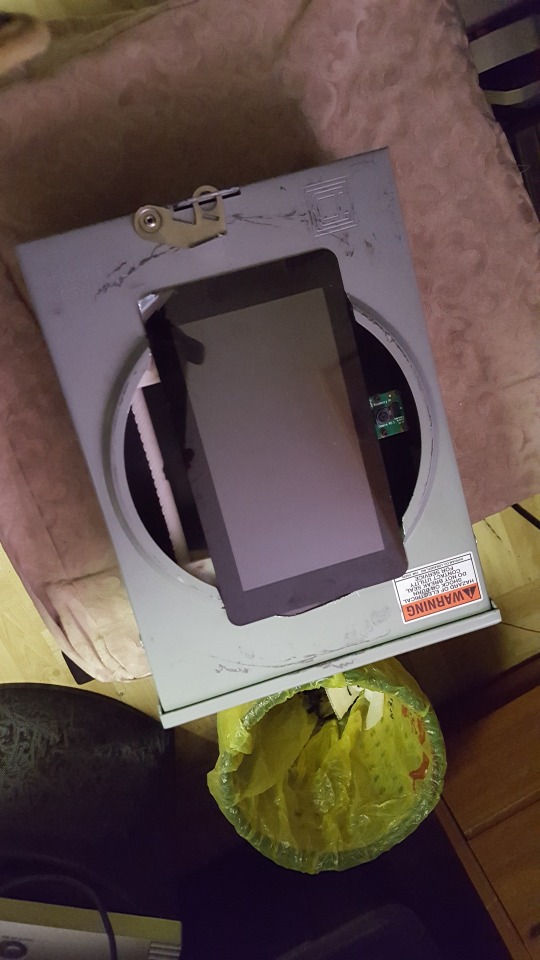
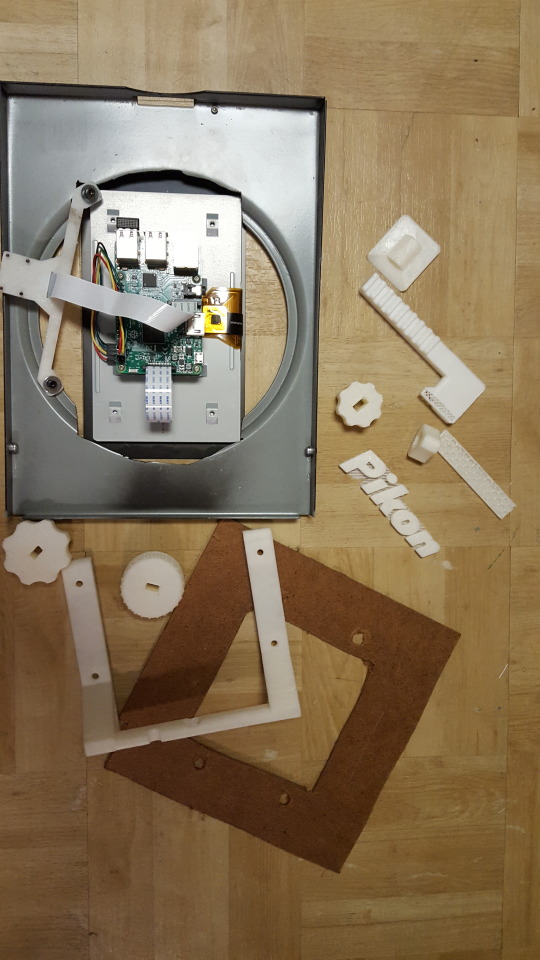
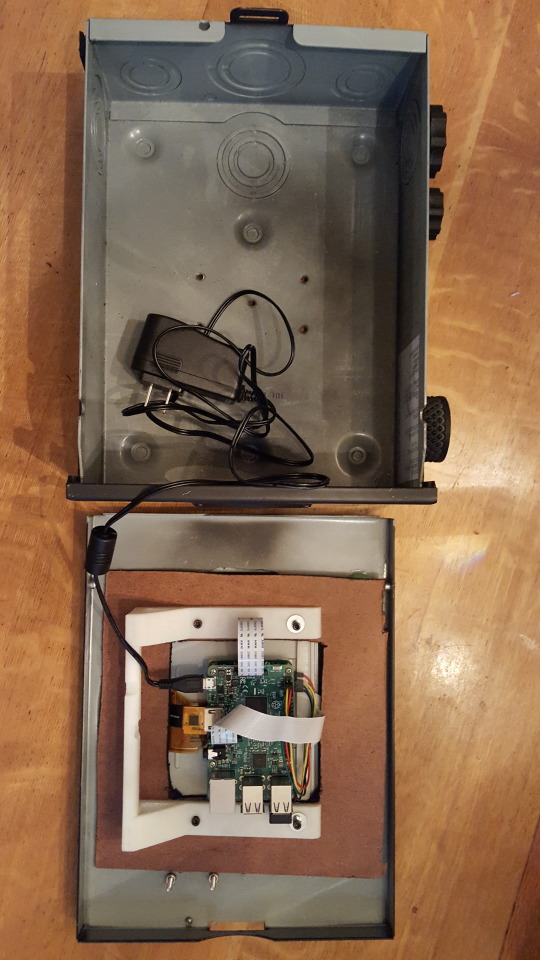
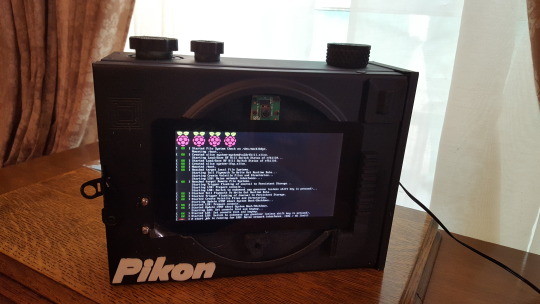

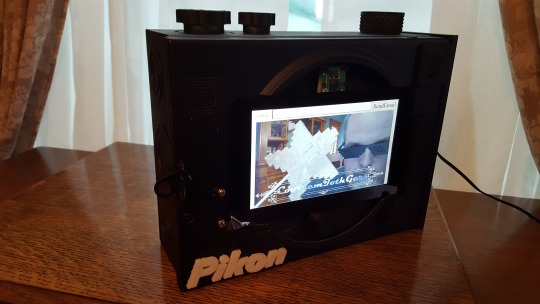
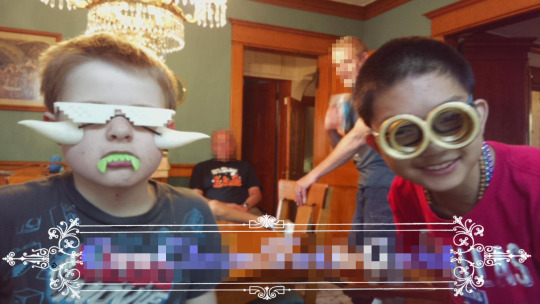
Family Photobooth
These days I am exceedingly busy, but I am still an avid reader of MAKE magazine. Luckily a lot of the DIY projects they offer use very small electronics like the Raspberry Pi -- I can start work at home, and bring the computer with me when I travel for work.
We have a nice large extended family with lots of kids, so when I saw the personal photoboth project in MAKE I figured it would be great to have one to bring to various events. The Mrs. and I first ran into this concept at a wedding last year, where some company had converted a VW minibus into a photobooth just like this one (theirs had a printer, which I may add to this at some point, but for now just a link to a web gallery). When I saw that all the (actual functioning parts) for this were Raspberry Pi and peripherals, I had to do it. I wanted to put it into an enclosure that looked like a big camera, but I also wanted it to be burly enough to survive all the kids.
The DIY guide is here:
http://makezine.com/projects/raspberry-pi-photo-booth/
I used an electrical enclosure from Home Depot (stripped out all the connectors, natch.
http://www.homedepot.com/p/Square-D-125-Amp-Overhead-Underground-Ringless-Horn-Meter-Socket-UGHTRS101B/100152068
Grabbed a bunch of camera looking knobs and gewgaws from an actual working pinhole camera design:
http://www.thingiverse.com/thing:728157
The rest was a jigsaw, black spray paint and lots of fighting with the Raspberry Pi 3 wifi connection. Now we are all set up, and the test run with the immediate family was a smashing success.
0 notes
Photo

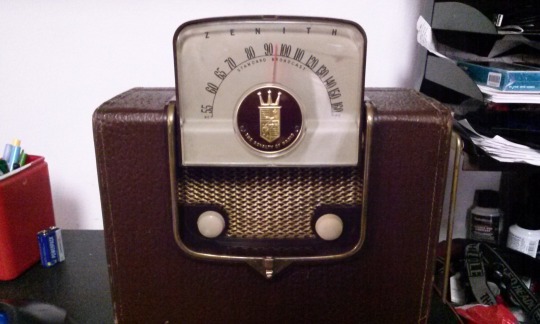

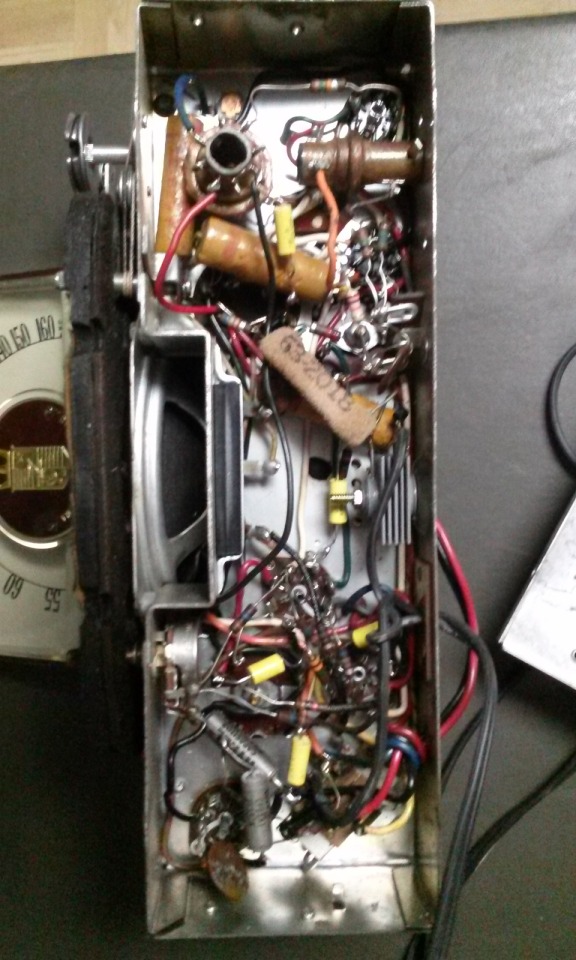


Working with old things
Earlier I posted about reviving the O scale trains that my family puts out for Christmas every year. I also have an old Zenith Model G503 radio that the Mrs. got me as a gift a few years ago – made in 1950 with a Bakelite and leather case. I used it in my shop for a while, then I had it in the basement, and then it stopped working very well.
I really enjoy tinkering around with early electrics, as everything is so straightforward (no integrated circuits) and really crude transistors when there are any. Switches are huge and clunky, and the technology is similar to what I built with electronics kits when I was a kid. One very good thing to note – some of these older devices energize the entire metal chassis when powered up. You never know, but it is good practice never to work on anything (or even open it up) when it is powered. Underwriter’s Laboratories was founded in 1894, but suffice it to say that consumer electronics standards have evolved a bit since this radio was built. The other things to keep in mind are that lead solder was the standard, as was asbestos insulation on wiring. So in short – don’t be dumb (I remind myself here)!
I’ve been really busy in the last several months, but decided to set this weekend aside to resurrect this radio if I could. Luckily, I have the internet! For tinkerers, this is truly the best of times. There is even an instructable that walks a person through what needs to be done, and I bet it is good advice for about 90% of the models out there.
Pulled the tubes, and even went to Surplus Tool on Alameda to try and find some replacements (no dice) – finally ended up buying a replacement set from vacuumtubesuperstore.com (– where else?). There may have been other people who spent $90 on vacuum tubes yesterday, but there probably weren’t many. I took the chassis out and looked for burnt out components, some of my old capacitors are shaky but nothing looked terrible. There are some modern resistors in here so my assumption is that it was refurbished before the Mrs found it for me years ago. Re-seated the tubes after doing some cleanup, and voila! I now get AM sports radio on my Zenith. It is certainly no coincidence that the Steve Czaban show was picked up by a Denver station this very week I am sure. My basement shop now smells like burning dust, and the tube performance seems to be degrading as they warm up – I assume the new ones will take care of that.
So, fixed without much effort from me. One thing I might try and add is a battery backup – this unit (see the handle?) was designed to be portable and had a battery pack. Because all of history is dangerous, the Zenith Z909 was a two part battery – part A was 1.5 V (that part I can do), part B was 90 V (!!) – I think I have to chain 10 9-volt batteries together to accomplish this. I think I’ll do it just to mess around with it.
0 notes
Text
Capitalism Ruins Everything
When I was in college, of course I was a socialist. I was an ardent admirer of Lenin and Trotsky, and would have many half-brained arguments with other clueless college kids who thought they knew something, too. After graduating, starting a business and after paying more dollars in taxes our first year than our total gross revenues, my tune changed. At that point I was something resembling a free-market libertarian/republican. I’m sure this was just as obnoxious as my socialist phase.
In the last 15-20 years my passion for thoughts on geopolitical strategy and economic theory has waned. Like most people I often get finished with work, do what I can to make sure the family is safe and happy, and collapse into bed so I can do it all again the next day. I still turn ideas over in my head about what system would allow for the best possible society, but I am saddled with memories of profound disappointment in our leaders from all sides -- this makes me a bit jaded I assume, so my new hobby is yelling at clouds.
These days I am a person in the private sector, doing what I can to earn a living and trying to maximize both the value of my skills and my free time. In the course of making my way through our modern capitalist society, I am burdened by the fatigue that comes with repeated prolonged exposure to marketing. I am sure I am not alone in the suspicion that for every bit of media that I consume there is someone trying to pry details out of me that can be used to sell me things. As I am now of formal curmudgeon age, I can state that when this was blanket advertising in a newspaper or during broadcast TV it seemed much less onerous. Today I am under no illusion that a record every click of a mouse, contact on a touchscreen, GPS reading on my phone, credit card transaction, NetFlix selection or (the worst -- including this one!) social media post is collected, categorized, collated, parsed, repacked and sold to someone who sees value in this information (to say nothing of whatever the NSA does with this info). I am constantly surprised at how many people I speak with that apparently never thought about this, and are at first skeptical and then complacent about the fact that a bored technician at Apple could probably email them a record of everywhere they went and what they did for the last 90 days. Does it matter that this is being collected? I don’t know, but I resent it, so I guess it matters to me.
Back when G4tv was a thing, Morgan Webb stated during an episode of XPlay that “watching advertising is how you pay for something without paying for something”. I agree. I have no issue with watching commercials during a football game, as I understand the bargain here. Of course, I pay for the electricity that lets me see the game, but it is an over-the-air signal, so my investment beyond that is my eyeballs and my time. Not so for online shopping -- the interface at whatever webpage is free to me, but I am paying for the item that I purchase - so why do the EULA of the all the e-commerce sites tell me that that they own the data about my data and they can use it to advertise to me (or worse, to anyone in my social circle)? This outrage is different from that of the folks who posted all the nonsensical legaleze on their Facebook pages in a spurious attempt to prevent Facebook from doing whatever they want to with any of the information that you put up there -- Facebook is free on the surface, but you are paying for it by giving them information they can sell. The fact that bothers me is that all this data collection is making advertising much cheaper, while at the same time much more pervasive. When companies had to print catalogs and mail them out to customers, the enormous cost prevented all but the most blanketed approach. Nowadays just clicking through a few websites without an adblocker will have you ignoring/cancelling/closing/muting more advertising than content in a lot of cases -- and the sites you visit will surely be tracking what you clicked on, how quickly you canceled things, whether you muted an ad, where you are and what other sites you have been to. You are monetized regardless of the outcome.
Yes, I will concede that companies are putting a tremendous amount of their resources into providing content or services that are essentially given away in exchange for their right to market to me. I will also posit that the balance is out of whack. The problem is, even if I paid for a subscription to the Wall St Journal or the NY Times, I would then get full access to their content -- and this content would be littered with the same (and in most cases even more intrusive) advertising and data collection that I will be exposed to on sites with no fee. My personal take is that I profoundly resent paying money to be advertised to.
I’m not opposed to advertising, or to capitalism in general, but it seems we have run off the rails recently. Anyone who has been anywhere near a television or a radio in the last month knows all about all the fantastic daily prizes to be had at the soon-to-be-outlawed daily fantasy sports betting sites. These guys know the jig will be up soon (see PokerStars.com), so it seems they have set out to co-opt all forms of media in an attempt to cash in now. This is allowed, and (for the time being) legal. This cash grab will probably be admired in a case study in Fortune magazine in a year or two. Forget the moral question of a system that allows carpet bombing the airwaves for a dubious gambling operation, it’s obnoxious on its face.
Many I am sure will decry a suggestion that a company’s right to do such a thing should be curtailed, and I think I agree. Like I tell my children though, just because you can do something doesn’t mean you should. I think my issue with this stems from an observation that business seems to be on a constant march to find the maximum amount of profit (not value) that can be squeezed out of any situation -- more often than not this means denigrating the value of your product in some way, while keeping the price constant. Most of the time these businesses overshoot, providing some dazzling short term financial results but genuinely wrecking the experience for the consumer (who would be the people who are actually providing all this glorious profit). Much of the time these ventures plod on, as they have enough market share to keep making bad decisions for years, or they are large enough to be able to request assistance from the government to keep their business afloat. Think American automakers in the 1970s.
Free market types (and generally I am one) will respond that this type of mismanagement provides opportunity for competition who can take advantage of the situation (think Japanese automakers in the 1970s). In a free market I agree, but we don’t have a free market. A good example of this is eBay.
I don’t know anyone who is happy with eBay today. People still grudgingly use the site because it is still the easiest place to buy and sell used things on the internet. All these people remember what eBay was like in 2000-2005, and the consensus is the user experience has gotten worse (for buyers and sellers), and the value of using the site has gone down. What happened? Is this good? Was the site unsustainable early, and is this modern version close to what the founders envisioned when they started it, putting into motion a 10 year trojan horse that would capture the biggest user base, which could then be exploited for fun and profit? Maybe, but I doubt it. I’m sure the defenders of eBay (shareholders and management) will bring up the concept of ‘creative destruction’ that they inflicted on the junk stores and collectibles shops to bring us all our second hand greatness much more efficiently. I am willing to concede this -- yes eBay, you are the WalMart of second hand stores, putting who knows how many small ventures out of business by removing the geographic barriers involved with nostalgic scarcity. You also provided all these small ventures with a new platform and new markets where they could cut their own costs and increase their volumes in exchange for a cut of their profits. So far I am totally on board.
Then came the success that lead to some dubious corporate decisions, acquisitions of Paypal, Half, Gumtree, Skype, Shopping.com and a position in Craigslist. Then came the aggressive drop off in revenue growth that normal humans consider a natural part of a maturing business (you can’t keep growing into infinity), but corporate officers see as hemlock, presumably because it impacts their share price and associated bonuses and invitations to red carpet events. Between 1998 and 2008, eBay’s annual revenue growth went from the 732% to 11%. I don’t think I need to point out that the first couple of years of this growth account for most of the company’s success, suffice it to say that the early years were almost an order of magnitude greater than anything after 2000, which is not surprising. 2009 was the first year eBay posted revenue growth less than 3%, and it has been hovering around 10-20% ever since then.
What happened around 2009? Well, a lot of really bad financial stuff. Aside from the financial shenanigans that resulted in a global panic and economic slowdown that we are still in today, eBay decided to change course. I remember reading some interview with Whitman or Donahoe around this time where they mentioned that they wanted to compete with Amazon. They didn’t want to be the internet’s garage sale, and that the real value of their company was eCommerce. This was the writing on the wall for me, and I realized that eBay as I knew it was going to change. That doesn’t mean I was happy about it. Then came the fee structure changes, the required Paypal usage and the changes to the feedback system that tilted the user experience towards the buyer in an auction, and captured much (much) more of the profit for eBay. There was gnashing of teeth and consternation (anyone remember PowerSellers Unite?), but in the end very little changed as far as the number of listings and the number of users at eBay. There is still no real alternative to the site.
Brilliant, right? Make the company more profitable by throwing your weight around and flog more money out of your most dedicated sellers. Well, business wise I guess so, but the user experience is degraded. Removing listing fees means buyers see the same items listed over and over again, obviously overpriced or unwanted but still taking up space in search results. Taking away the power of negative feedback and seller representation in disputes means that sellers have to price things accordingly (or stop selling altogether), and now are faced with a value proposition that only includes access to a user base, at a steep cost. I’m sure some bad actors on both sides have been excised from the site, but in general these changes are a net negative for both buyers and sellers. Was this the bargain that all the small stores that went eBay-only in the early 2000s signed up for? Originally it was ‘Reduce your costs, increase your customer base, sell you goods on your schedule.’ Who wouldn’t want that? Unfortunately the proposition has now changed to ‘Increase your costs, add problematic buyers to your customer base, and now you have no alternative.’ For buyers this went from ‘Hard to find items at auction prices’ to ‘Limited selection of overpriced listings along with bushels of stuff sitting in a warehouse in Taiwan’. I should have added “mwa ha haaaaaa!” to that last statement, as it sounds so nefarious, but in reality this is what happened.
Again, is this what Omidyar envisioned in 1995? Is this what all of us wanted when we started using the site? Was this plan spelled out in the SEC filings in 1998? No. What happened? Well, business people happened. Shareholders happened, and both of these things happened to all the other innovative companies that arose in the late 1990s. These things eventually happen to just about any successful venture that wants to expand. I would argue that the aspiration is laudable, but in a lot (maybe even most cases) both businesses and their customers would be better off if ownership is kept private. I suppose success depends on your frame of reference, but as a consumer I keep seeing value being reduced. To be fair, prices are also being reduced, but the ‘race to the bottom’ on pricing can also be tremendously destructive. The current strategy among businesses seems to be that this is great, so long as you are the winner, then you can really start making money because you have driven everyone else out -- now you make the rules. This is the point where everything great about capitalism becomes everything that is wrong with it. One of the issues with relying on the market to correct inefficiencies is that the mobility is assumed. If eBay already has 100 million users (along with all their payment information and transactional history), it is not reasonable to assume that an upstart internet auction site can come along and supplant them, save for some enormous (more enormous than the enormous ones they have already made) misstep on the part of eBay. Ubid, Overstock, eCrater even Amazon and Yahoo among many others have tried -- sure the sites work great, the fees are close to what eBay used to be (if not less) but the bidders are just not there. eBay is entrenched, and they know it.
The example here is eBay, but a similar story exists for any venture that has been able to capture a user base and exploit it for maximum profit. This really goes beyond the true antitrust targets of the Justice Dept of Standard Oil, US Steel, AT&T, IBM, Microsoft -- what these companies did is the same as what we see from Wal-Mart, Amazon, Comcast, the NFL and yes, eBay. The former just managed to do it so well they got the government on their case. The reality is that all businesses large and small would love to have a monopoly because it is easier to make tons of money with no competition. The larger ones are smart in going about their business to either appear to not be a monopoly, or fund enough politicians that they are allowed to exist as one. Only the dumb ones leave a paper trail in their collusion to keep smaller players out, but rest assured it is happening at all levels.
I think the problem is that the monetize-at-all-costs (snark!) thinking has bled into all sectors indiscriminately. Ever donate to what you think sounds like a good charity, only to be flooded with solicitations from dozens of other charities you had never heard of? The initial beneficiary of your goodness sold your information to a broker, who then sold it to all these other charities, who then pay for-profit companies to try to get you to donate -- makes you wonder. How much of your donation is going to help the people you wanted to help, and how much is going to print flyers and pay people to telephone others to get more donations? How did the priorities of a charity get so twisted? Well, my guess is they hired consultants, or even paid staff that had taken this approach in business and had some success. I am also assuming that this type of blanket approach works (at least for getting more money in the door), but my question would be -- what is the net net for the people you are trying to help? Did you actually do more good, or did you just grow your staff and put more money in the pockets of marketers; doing your donors a disservice at the same time? Someone should be putting these questions to those who run charities. Yes, I know that not all charities are bad (we donate to several regularly), but the fact that you have to protect yourself from solicitation when you are freely giving funds to a charity speaks volumes about people’s motivations and priorities.
This occurs even in the smallest of grassroots endeavors. I run in a bunch of small, independent racing events any given year. There is no audience for these things, and usually no prize money for the winners, so they are ostensibly for people that just like to get out and run. Without fail, each year the registration fees go up, sponsors creep in to the proceedings, and the experience is either no better, or isn’t as good. This may be because the event grows so large a new venue (or sometimes even a new course) must be found. On paper this sounds great, and in reality the shirts get nicer, the schwag bags have better goodies, and the announcers are more professional. You know what though? I don’t care about any of that. I want to run the race and enjoy being outside. I must be in the minority here as this expansion keeps happening -- it could just be that people are so used to this they don’t notice. Well, this year the Denver Marathon, which used to be a fantastic run through all of the historic neighborhoods of the city has announced that this will be the final event, and of course now the race starts in Brighton. This is after the race was sold to Rock N Roll Marathons (or whatever they are called) in a bid to grow the event. It was sold in 2010, and after an initial bump the race is now smaller than it was in 2008. Those shirts sure are great, though.
There is hope, however. For the organizational leaders with real vision it is possible to push back against all the forces trying to push business to a place they never intended to go. As an example of this I look at the Wild Animal Sanctuary in Eastern Colorado. This place has a very large facility housing rescued apex predators. A very cool idea in that animals are taken from some really dire circumstances and given a large open habitat where they can live out their lives with others of their kind. I don’t know what their total animal count is, but if I had to guess they probably have a couple hundred large cats (lions, tigers, panthers) as well as bears, wolves, and just about any other dangerous animal people would misguidedly try to raise at their house. A really great attraction, and we took our kids there several times. This past summer, the organization took a lot a criticism because they closed their doors to the public. People can still get in to see the animals if they become member supporters, but a general admission policy is not in place, and the membership level is expensive enough that they probably excluded 70-80% of their attendance. Stupid, right?
Well no, brilliant actually. Reading though their justification, it was clear that admitting the public to their facility was costing more than it brought in. Not unheard of for an attraction of this size -- the normal (and lazy) response would be to start charging for parking, increase the admission fee, get more sponsors and staff up -- all of which would probably result in a moderate increase in gross revenue, but which could be a net negative for the actual goal of the organization, which was to provide a sanctuary for the animals. They had the courage to shut the doors because they didn’t want to be sidetracked by growth in areas where it wasn’t important. Bravo, Wild Animal Sanctuary (though your newsletter could have been a little less preachy)! I wish more organizations would make tough decisions like this -- it would be better for everyone -- even those people that don’t go to your facility, as you are choosing to decline their business rather than exploit them.
I am not a socialist anymore, although I do acknowledge the reality of the social contract. Being a part of our society means businesses can do what they want, so long as it isn’t illegal. I am tilting at windmills when I argue that we should expect companies to act with something more than the dollar in mind (except finance companies, as that is all they know -- they should be heavily scaled back and regulated just because they are acting like jerks now). Free market radicals will tell me that the dollar is the only reason that companies exist, and that I am stupid for suggesting they consider other factors. Maybe that is true, but I would respond that companies have employees and customers that are part of a larger community, they have human motivations and aspirations, and human weaknesses. The best way for things to proceed would be a relationship where companies don’t prey on their customers, and customers don’t have to be suspicious of who they do business with. If you do something well, or have a product that has value you will do fine, all things being equal. If you are depending on years of losses and a planning a massive marketing blitz to become established so you can crush your competitors, you are predatory, and you should be regulated. If you can’t think of any way to improve your margins that is more original than raising your prices, or exposing your customers to more advertising from third parties, maybe you should look at what you are doing and decide if it is a good thing to keep doing. Just sayin’.
This is all one giant platitude, that boils down to ‘Attention businesses and charities: I know what you are doing and I see right through you. Stop treating me like I am stupid’. I know that you are reducing the weight of your products and keeping the boxes the same size. I know that you use high fructose corn syrup instead of sugar because it is cheaper. I know that one of six people ‘struggling with hunger’ actually means “at times [within the last 12 months], unable to acquire adequate food for one or more household members because they had insufficient money and other resources for food. A majority of food-insecure households avoided substantial reductions or disruptions in food intake, in many cases by relying on a few basic foods and reducing variety in their diets.” -- by this definition, everybody I knew in the 70s was ‘struggling with hunger’. I know that this post will be word searched cached along with others that have similar keywords for future use, and I know that my chances of winning a daily fantasy game are worse than my chances of winning the lottery. I think a lot of other people know this too, and my guess would be that once they think about it they would agree. In its unchecked form, capitalism ruins everything.
0 notes
Photo

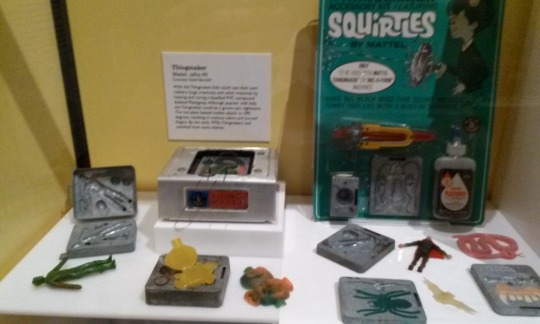
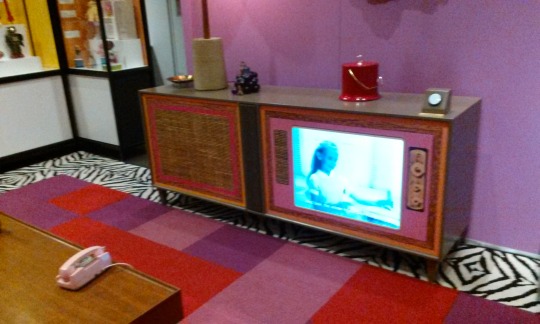
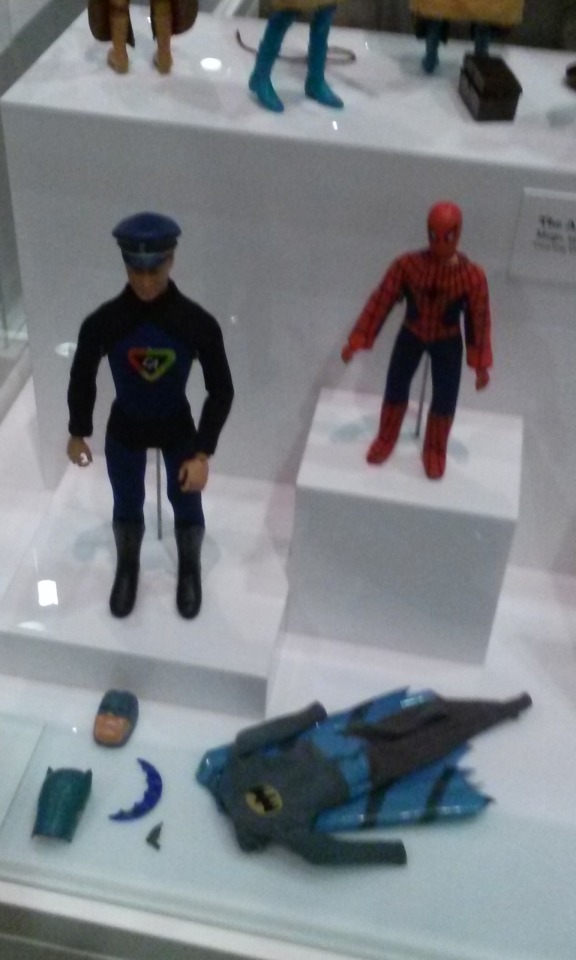
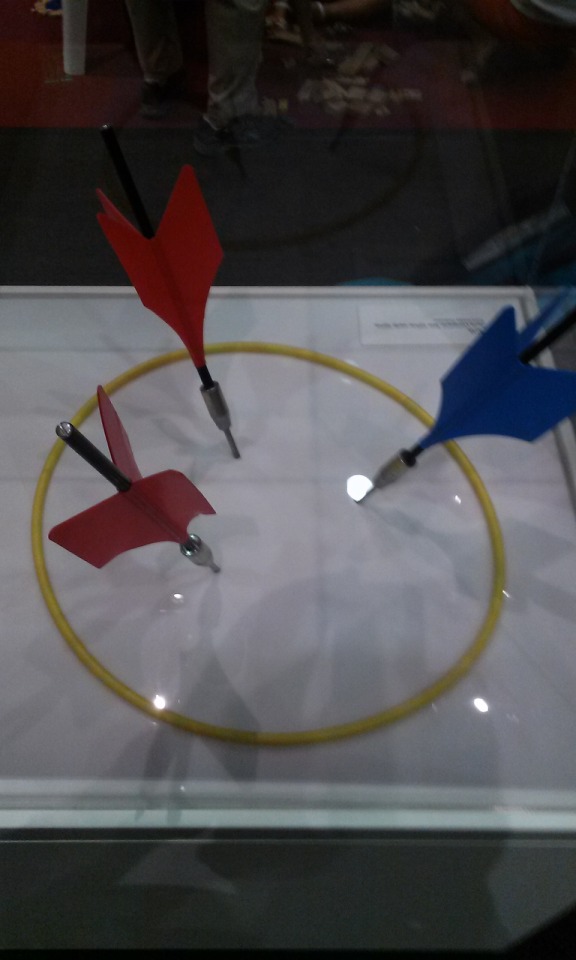
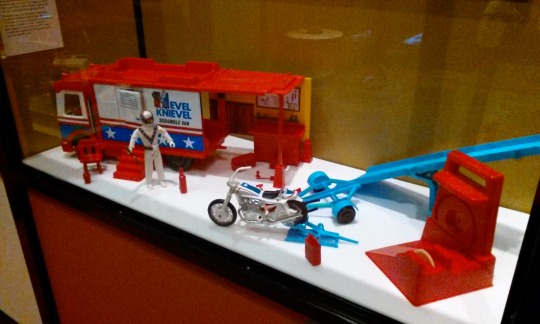


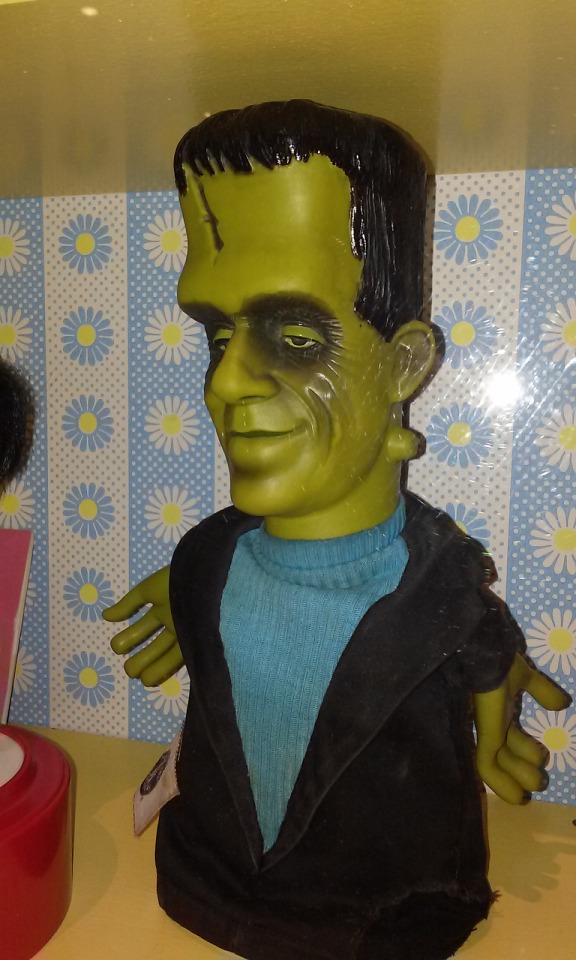
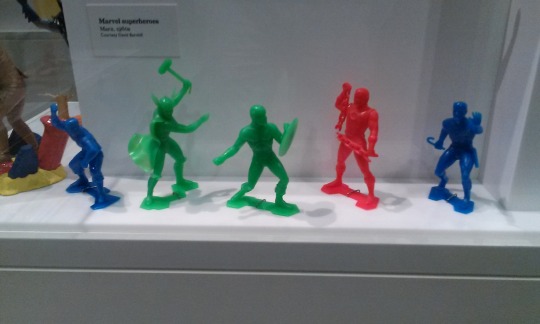
Toys... so many toys.
The Colorado History Museum (or the History Society of Colorado or the Coloradistic Historicity Building or whatever they are calling themselves today) hosts some very cool traveling exhibits. Currently it is the the ‘Toys of the 50s, 60s and 70s’ collection. The Mrs and I are very into toys, some people call them ‘vintage’ but we call them ‘toys we had or wish we had when we were kids. This exhibit was right up our alley.
One of the things we were surprised by was the change in attitudes over the years, even in this small sample of toys from a long time ago. We’ve been buying lots of toys for our own kids in recent years, and it is really interesting how there has been a de-emphasis on outdoor play, and a very clear progression away from outright military toys and towards safety at all costs. I don’t think anyone is going to agree that Jarts were a good idea, but I do remember my Bigwheel being a huge part of my early childhood, whereas today it is that thing you ride at grandmas house once in a while. Likewise, I sent some pictures of the chemistry sets from the 50s to my stepdad as I knew he had one...when my boys saw that the old chemistry sets actually had acid in them, and that one of them encouraged glass blowing they were astonished. “Gee, that sounds safe, dad.”
I suppose the lament of every human is dealing with change, and while the toys from these eras are attractive because they represent the early development of the monolithic toy industry in the US, they are also fascinating as they are marketed towards a different society than the one we live in today. The fully realistic all-black M-60 machine gun on a tripod (including grenades for throwing) has been replaced by the dayglo Nerf dart shooter. Little boys still love to shoot things, but now it is targets instead of commies I guess. Some of the original D&D manuals were there in their black and white printed glory, a far cry from the piles of Magic cards we have now.
Our family celebrates toys, and a lot of times we break out some of the old favorites to play with our own kids. Because we hold on to most of these (and display a lot them in our house) we are the recipients of some of the really early toys from the family collection, from my grandparents cast-iron horse and carts to my mom’s Marx tin toys and board games, and recently several of the HO scale Lionel trains. I think they are great.
One of the things that fascinates me is the engineering that went into (and still goes into) making a lot of toys.I think it is the low bar of performance (yes, it has to make sparks, but that is all it has to do) coupled with the requirement to keep costs down has lead to some really innovative thinking. When I was a kid, my parents bought me a toy called the Armatron from Radio Shack -- basically a robot arm with a couple of control sticks you could use to move it around. I thought it was great, but I remember being disappointed that the cables on the outside of the arm were just rubber decorations (I guess I was hoping for hydraulics? I dunno). I eventually took it apart to see how all the gearing worked -- nested planetary gears all made out of plastic, with all of the movements of the arm run by maybe 3 motors. I was impressed.
Anyway, this exhibit brought back a lot of good memories, and I was thrilled (as were the kids) that they had a lot of older toys out where kids could play with them. Naturally, all the electronic ones had dead batteries.
0 notes
Photo

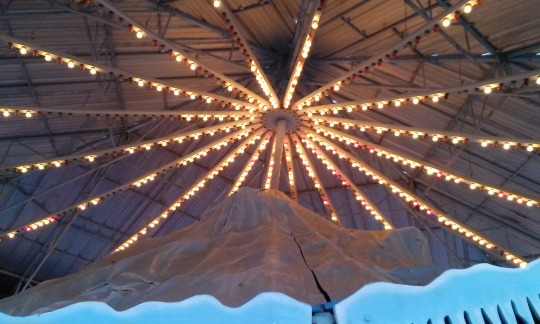

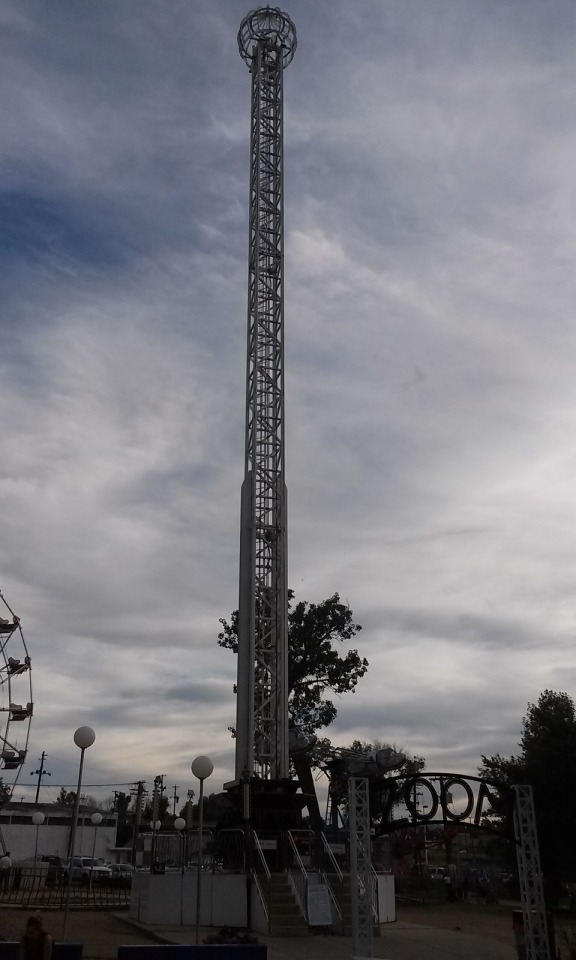
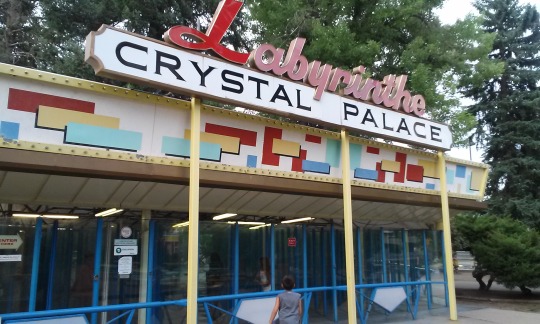
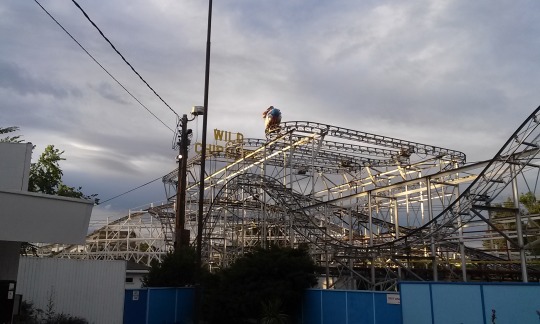



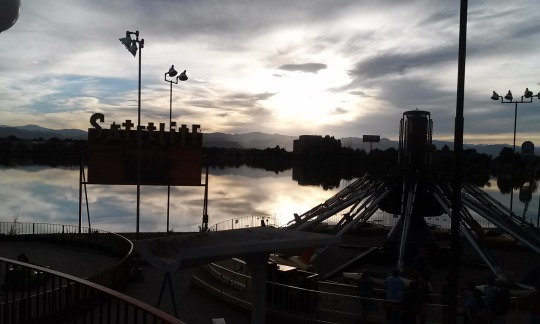
Lakeside!
One of my favorite places in Colorado is Lakeside Amusement Park. It used to be the less expensive alternative to Eliche’s (and it still is...by far) but now it is even better as Eliche’s relocated to a barren parking lot downtown and tripled their prices after being acquired by Six Flags Conglomerate of Overarching Consolidation Incorporated. Both the Mrs. and I went to Lakeside as kids, and we have been taking our kids here since they were little. Admission is $4, and unlimited rides are $12. A little more on the weekends, but still a much better deal than other amusement parks *cough* all of them *cough*.
Lakeside is still family owned, they still employ high school kids to run their rides, and they welcome families with picnic baskets. Sound weird? It kinda feels that way, as we are all so conditioned to pay a lot of coin for everything and just grumble silently while we pine for the good old days. No grumbling at Lakeside.
The clientele is different than what you find at more modern parks, but who cares? I have never had trouble with anyone at Lakeside as I think we are all so happy to be at Lakeside...plus the kids can learn some Spanish while we are there. Most of the buildings are leftovers from when the park was new and have a very cool art-deco vibe.The signs for the restrooms are stained glass, and the street lights you see have been converted from gaslights. There are rides at Kiddie Land that were old when I was a kid. I would still ride the motorcycle carousel if they would let me. In the 70s the horns on the motorcycles still worked and man I played a mean fake-motorcycle horn. The have a ride called the Midge-O-Racer where you can actually steer your little car in and out of the circle it is driving in. My sons were in love with this ride even if they were too scared to ride it for a few years.
The signs are hand-painted (and most of them are faded) and half of the machines in the arcade don’t work. You never really know which rides will be open, and there always seem to be huge lines for tickets - but they always move much faster than you think they should. Teenagers hang out flirting with eachother and looking surly at everyone else. There is a little minature train that will take you around the lake if you want (the lake is kinda nasty).
The only (I mean only) thing I would change about Lakeside if given the powers of a deity, would be a return of the funhouse. I think they tore it down in the late 80s -- and they probably should have. I think anyone who grew up in Colorado in the 60s, 70s or early 80s can tell you about getting hurt in some manner in the funhouse. They had slides made up of carper rollers (!), a turntable designed to fling children in all directions, rolling barrels that a person could get stuck in, and a human centrifuge they called the Monkey Cage (you could totally crush all your friends in there). I loved it all, right down to the totally scary animatronic laughing fat lady who never shut up.
Lakeside, never go away. I know at some point you will have to change, but put it off as long as you can, ok?
0 notes
Text
Martial Arts and Family part 14
I had always considered it a point of pride that I was dedicated enough to kendo that I would be the first to arrive at the school, practice the hardest and be the last to leave. This is true when I became the undisputed leader of the class, and even bled into the regional practices. I had once stated that I loved kendo so much I wanted to die by collapsing on the dojo floor (I was young(er). One of the sensei in the London dojo told me that one of their elder teachers actually did that, and it left a dismal pall over the practice hall from them on. I reconsidered.). This also -- at least in my mind -- is what lead to me taking on an unhealthy amount of responsibility for the school and got me to the place I found myself in late 2012. I had already decided that I needed to ask my teacher for a change in the dojo dynamic, and I was first trying to convince myself that I could somehow keep practicing and just set some things free. I knew it would be a constant struggle, but at least I was clear on this going forward.
Then, life. We had been working with our older son's teachers and therapists (and still are) heavily on his progress. While the real definition and the symptoms of autism are maddeningly varied, the general understanding is that the best chance to help children with autism grow is by determining how they learn, and then adapting your approach to make instruction as painless as possible. In years past (back when our country actually had something resembling mental health care, such as it was), most of these kids were probably deemed behavior problems and just put in a corner, essentially (or worse, shut up with a bunch of other kids that had varying problems so they could dysfunctionally regress together). Once they were adults, many of them were incapable of even taking care of themselves, much less leading a productive or happy life. This is the fate we want to avoid for our son if at all possible.
In our case, our son has difficulty when his environment provides too much sensory input (visual, aural, olfactory, tactile -- too much is too much). His doctors and therapists tell us this is common, and I agree with their sentiment. Loud environments, schedule disruptions and a lack of confidence are his kryptonite, and each of these three things feeds into the other two. The Mrs. and I (mostly the Mrs.) worked very hard to get him placed in schools where this was understood and accepted, and luckily we found teachers and therapists that first taught us what was going on, and later served as interpreters for us as our son has grown. We still interact with most of these people.
It was in late 2012 during a meeting with these folks where we were told that the next few years of our son's life were basically the crux of his development. We had done a good job of getting him to this point, where he was engaged, he liked school and he was receptive to social therapy. He was (and is) still several years behind where he should be in most subjects, but he is social, and he is progressing. As I understand it, just like a lot of typical teens start to shut off the world when they are confused and uncertain about their place in it, autistic teens will shut down all together, and it can happen very fast. In our experience with our son, when you lose ground like this it is very hard to make up.
I had known for a while that our son was less confident when I wasn't home with the family, but I assumed it was because of his age. It wasn't that I needed to be an active part of his therapy, I just needed to be there, or moreso when I wasn't, it certainly affected him. Well, any read through the previous posts in this series will give you a pretty good idea of how kendo practice was increasingly taking me away from the family. So, I made a command decision.
It wasn't easy, but I decided I had to step back from kendo immediately. I called my sensei to tell him, and he wasn't happy, but he certainly didn't tell me that this was a bad idea. I wrote an extended letter to the entire class (and several of the regional federation leaders) to tell them I had to put kendo down, and I didn't know when or if I would come back. I still don't. I transferred all the dojo information, the checkbook, the records, the inventory and the legal responsibilities to the senior students at my teacher's request. I thought I had set up the dojo as a limited liability partnership, but legally it was apparent that it was no different than a sole proprietorship once I started going through the details (whoops). I transferred the trade names and notified the IRS that the FEIN was no longer active. I don't remember if I attended one last class or not -- probably not, as I am sure I would have felt guilty and sad being there. I was contacted individually by several of the senior students who wanted to give me small thank you gifts. I also received a very nice note from my sensei where he thanked me for everything I had contributed over the years. It was heart-wrenching, as this was a group I had spent more than a decade practicing and growing with.
The change had almost instant results with regard to our son. Now I was home for dinner every night instead of 3-4 nights a week. I still had to travel for work, but since these trips were defined as short term absences in his mind, they didn't seem to bother him as much as having me miss so much time on a regular basis. He is still struggling, but he is much less anxious, and it is easier to get him to calm down (most of the time) when the world has swamped his senses. I was also much less tired, as I didn't have so many late kendo nights. From the first week of this new dynamic, I suffer no regret over my decision. I also have no idea whether our son will continue to develop, or what his long term prospects are, but I know that spending more time with him and the rest of the family is certainly not hurting.
For a few months, I practiced diligently on my own -- and even with a kumdo school on my own terms (later post, natch). This ongoing practice had me thinking about setting a schedule for returning to class, so I decided to give this up as well, and focus on training where there was no danger of missing more of my children's development. Currently this translates to getting up stupid early and working out at the house, or getting up even earlier so I can go out for a long run and be back just as the kids are waking up.
I miss kendo terribly. I miss watching students get better, and I miss the feeling of total exhaustion that an honest practice will elicit. I miss the comradery, and I am fully aware that I was one of the stronger competitors from our region and seen as something of a model for Western students that started as adults. I have to admit, I even miss the kid’s class at times. I feel like I let my sensei and all of the other teachers that invested time in me down in some way. I guess it depends on your perspective; I probably did. Happiness in life is in large part defined by accepting one's limitations, and the path I chose when we adopted our son (and then had another) is the foundation that my life will be built on. I knew it then, I am just more honest with myself about it now.
0 notes
Photo


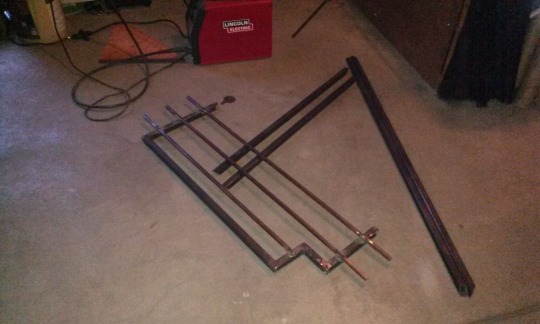
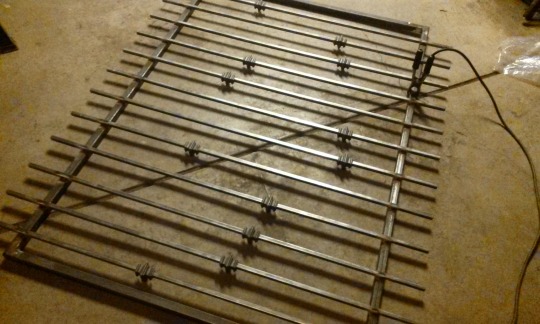
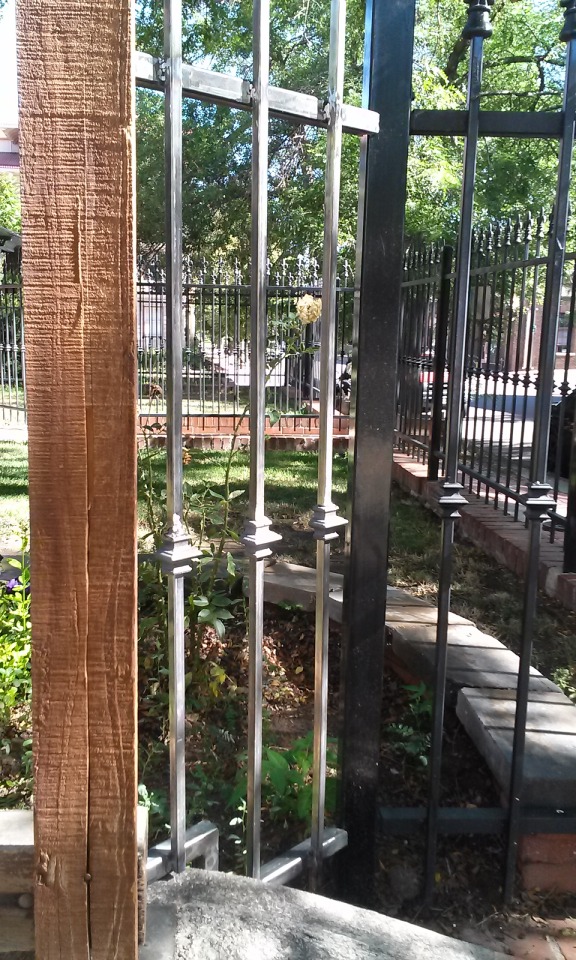

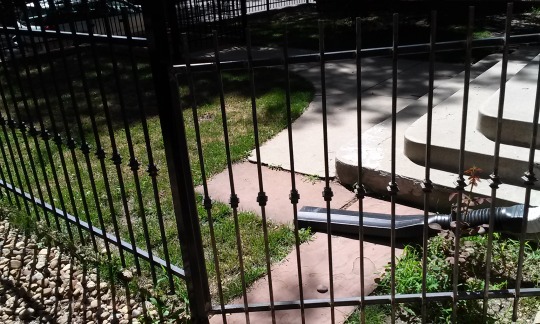
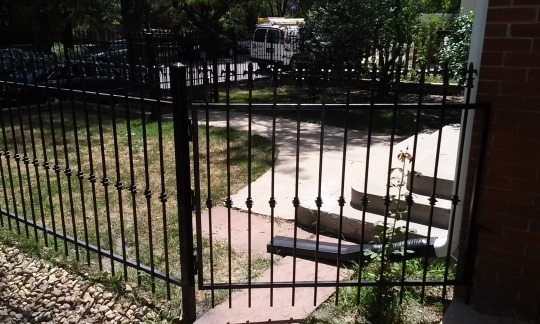
Welder!
Two careers ago, I ran a manufacturing plant. I had a maintenance crew, who didn’t resent it too much when the boss told them he wanted to learn how to weld. They gave me a few quick instructions and set me up at the fab table with a MIG arc welder. I did okay, and all the welders on site were kind enough not to comment on my crappy skills. As a Christmas present, my guys bought me a Huntsman welding mask of my very own. It is basically riveted cardboard, but it works.
I’ve been on the lookout for a good deal on a welder for several years, but I just couldn’t justify getting one unless it was a really good deal. Fast forward to early this summer, and we had a pug problem. Our little savage loves to run around the front yard intimidating no one. The problem is, we have a fence that doesn’t form a complete enclosure, and in those instances when someone really needs to be barked at personally, the 20 lb. dominator makes a low-speed escape. Not hard to catch him, but the neighbors are renters who don’t clean up after their dog (<sarcasm>renters -- who would’ve thought?</sarcasm>), so chasing after our sluggarly escapee means a trip through the minefield -- eeew.
We went to an estate sale that was advertising pinball machines (there was a sweeeeet Spider-Man table), but by the time we got there the machines had been sold. The seller was an aging gearhead, and had all kinds of tools for sale, including a bunch of welders. I made an offer on a fantastic Lincoln Electric Weldpak 100 MIG welder and got it! While I was carrying it to the car, another gearhead was walking up and tried to buy it from me for just over what I had paid for it -- no deal, Mr. Gearhead. This welder is mine!
A couple of trips to the Metal Supermarket (yes, there is such a place -- its actually a huge chain), and I set about to making our missing fence piece, and a new gate so we could corral the lardsome fury known as our Pug. I am getting better, but even my weak skills make a pretty nice fence!
0 notes
Photo
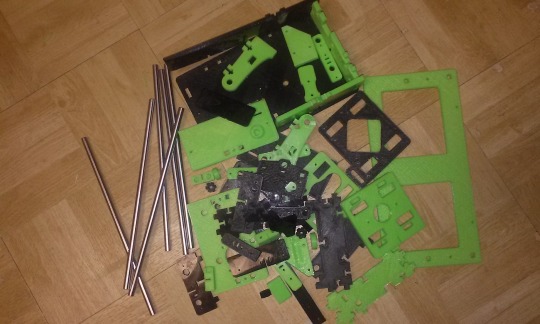
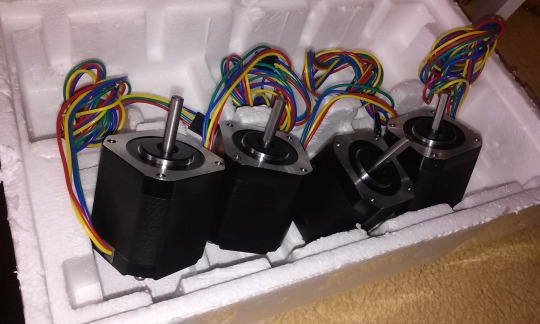
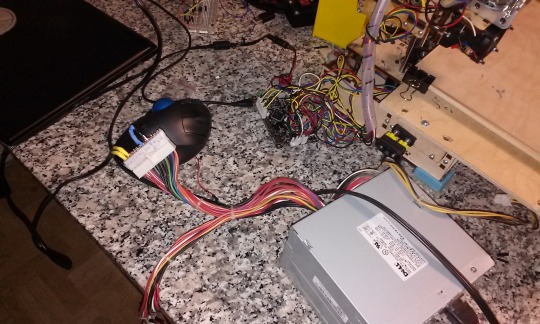

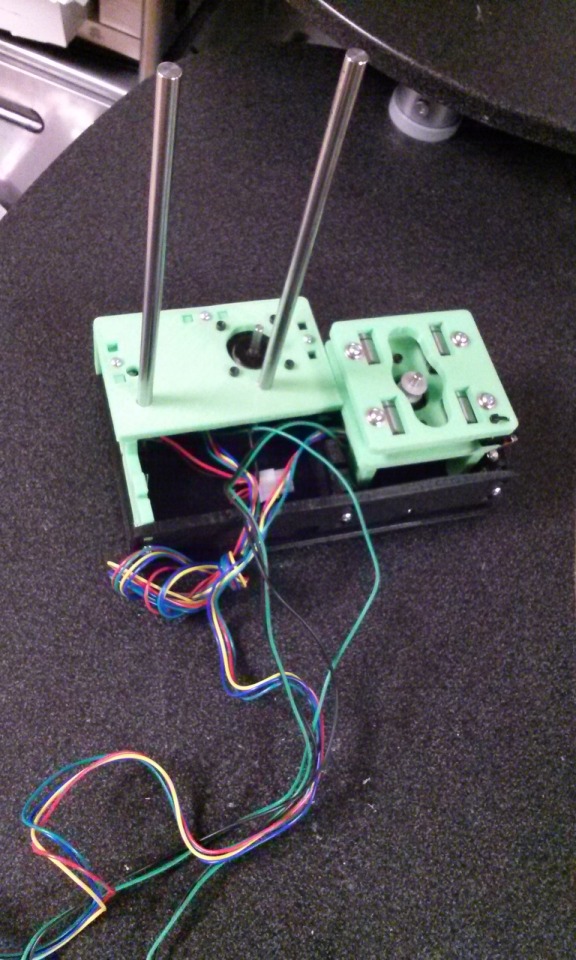


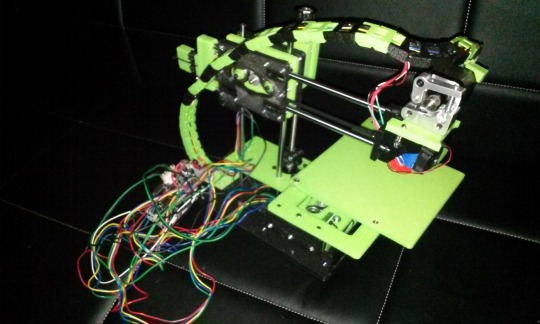

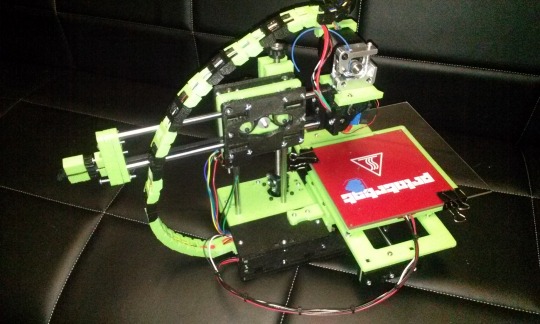
My Printer made a printer
As I posted a few months ago, I decided to follow the original RepRap initiative of using a 3D printer to make another 3D printer (...well, make the structural parts of the 3D printer).
The unit I have almost all my experience with is the Printrbot, so naturally I went to make another one. Luckily, Printrbot doesn’t object to having their structural designs in the public domain (they shouldn’t...in making this printer they sold me a new Printrboard, an AluExtruder and a heated bed). A user on Thingiverse posted files that I used to print all these out. I also used some improvements I implemented in my initial unit, but the core design is unchanged.
I have gotten more comfortable working with the mechanics of printers as well as the Printrboard. I ride my original printer pretty hard, so I have burned up power supplies, fried motors and destroyed hot ends. In keeping up with the hobby I have probably built my original unit a couple of times, so I didn’t see making one from scratch as too big of a challenge, just a lot of time. Well, things don’t always work out like they should, and I spent more than one evening (or morning depending on the day of the week) with calipers out, having to re-print parts because the originals were just a little too big, or didn’t take into consideration the fact that I am using a different extruder.
My plan is to give this printer to my boys so they can do what they like with it. They are still a bit young for it, but it never hurts to start the gears in their heads turning. While I am sure this commits me to eternal tech support on the printer, I’m good with that.
Links and details:
Printrbot Jr design, heated bed, thermister, AluExtruder and Printrboard Rev F www.printrbot.com (the Jr is obsolete)
E3D V5 extruder http://e3d-online.com/ (the v5 is obsolete, I use the v6 in the Monstrbot)
Belts, GT2 pulleys, endstops and bearings from EasyReprap http://www.easyreprap.com/
Rods and threaded rods, brass nuts and borosilicate bed from from McMaster-Carr http://www.mcmaster.com/
Stepper motors from Automation Technologies http://www.automationtechnologiesinc.com/
Printrbot Jr Files: http://www.thingiverse.com/thing:142754
Z axis mount (improved for M8 metric rod) http://www.thingiverse.com/thing:64738
Tensioner units: http://www.thingiverse.com/thing:123202
Cable chain http://www.thingiverse.com/thing:668048 (had to modify this for the 90 degree turn)
Extruder mount -- my own design, send me a note if you want it.
ATX power supply hack http://makezine.com/projects/computer-power-supply-to-bench-power-supply-adapter/ (cut the connector to the bot off an old laptop supply and wired it in)
0 notes
Photo
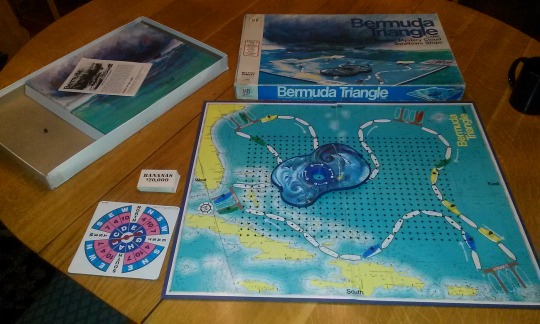
The Bermuda Triangle!
My wife was telling me about the memories of this game, so I found one on FeeBay. We can now compete for international shipping supremacy while dodging the ‘Sinister Mystery Cloud’ that haunts the Bermuda Triangle.
I had to 3D print part of said cloud to get the cheesy magnet system to work, and there wasn’t too much mystery involved, though I did try to arch my back in a sinister manner while I drew it up in Blender. We’re good to go now, though I think I need to print some more ships.
The Bermuda Triangle was all over made for TV movies, comic books and general pop culture back in the 70s. What happened? You don’t hear about the BT much any more. It’s a...wait for it...mystery.
Anyhoo, we’ll be using our holiday to see who is best at the logistics of getting banana deliveries to Texas at the highest price this weekend. Fun? Fun. And mysterious in a sinister way.
1 note
·
View note
Text
Dad
I mentioned before that I lost my father at a fairly young age. I have many reasons to pretty much disregard everything about him, as (even in his own eyes) he was incapable of being a father to the family he had sired. As the recipient of his decision to abandon us, I should be (and spent several years) pretty angry with his decision, and with him. Humans are funny though, in that our formative experiences -- and almost all of those involve our parents early on -- leave a deep impression that we never really leave behind. I still think about my dad a lot. Probably more than I should, and certainly more than his memory deserves.
I have a stepfather who came on the scene several years after my dad died, and he did a fantastic job of keeping me (most of the time) on the straight and narrow -- helping to foster my intelligence and show me how to be a grownup. We had minor clashes over the years, mostly because I was a knucklehead and he called me on it. He’s a great grandfather to my children.
I still have a lot of my dad’s things, including a manuscript of a book he wrote, his philosophy books from the early 60s, and several of his minor writings. One of these is titled “Thoughts on Suicide” that is dated the same year I was born. In it he lays out a cogent case for why death is the best option when the pain of living is too great, and that as a human it is everyone’s right to take part in ‘the ultimate selfish act’ (his words). He then went on to father my younger sister before deciding (I guess) to take this course. This was all in the early 70s, so no one was really talking about clinical depression. I have read about half of my dad’s books, and I try to make sense of his notes in the margin. It is pretty heavy stuff -- Jaspers, Sartre, Fromm, Kaufmann and of course the true icons, Nietzsche, Kierkegaard and Heidegger. When I was younger (and therefore stupider) I read them without really understanding the context or getting the meaning. Like a lot of other twenty year-olds I read The Will to Power thinking that I finally found the underlying cause and effect of everything. So dumb. I revisited several works (and I still read them on and off) after having some experience with life and some extended knowledge of the authors and I see now why the world has college professors. Without the framing story on a lot of the very fundamental concepts, a person has little chance of understanding what he/she is reading in these. But I digress.
I sometimes wonder how far my dad got into existential philosophy before he graduated. Without context a lot of the ideas could easily find their way to despair and nihilism. I am grateful that in my own understanding and quest for knowledge I discovered (and then re-discovered) Albert Camus. He is my answer to the trite ‘who would you want to meet out of anyone who ever lived’ question. I don’t suffer the conceit of wanting to talk with Aristotle, though I am sure he or Hannibal (the Carthaginian, not Anthony Hopkins) would be fascinating. I have a copy of the Myth of Sisyphus in my office that I read though every once in a while. I bought it myself, and I wish that my dad had read it. He may have, but apparently it didn’t make an impression or if it did, it was the wrong one.
I have some very vivid memories of time with my dad when I was young. I remember seeing the King Kong remake with him in the theater -- given the release date I must have been 5 or 6. I remember being thrilled and horrified when Kong kills the giant snake. For some reason I also remember the sound of one of the helicopters crashing in the theater towards the end of the movie. There was a diorama at the theater with a huge King Kong sculpture set up -- you could sit in a chair behind his hand and it looked like he was holding you. I remember sitting there and asking my dad to take a picture but he didn’t have his camera so I didn’t get one. That would have been a cool picture. I also remember shooting his 0.22 pistol at cans when we were camping. He put me between his legs and let me pull the trigger while he aimed. To the young me these were great times. They are nice memories, but are now colored by my understanding of how dad probably thought of them. I can honestly say I remember hearing my dad laugh so I am sure it happened, but I can’t remember ever seeing him smile. Maybe by the time I was old enough to be able to remember this clearly he wasn’t smiling any more.
In the abstract my dad gave me the greatest lesson I could ever get by showing me how to be a father in deed but not in spirit. The day that we found out about his death I awoke to the sound of my mother calling me to her room. We were at my grandparent’s house -- dad had been there with us for a week, and we were scheduled to stay another week while he had to get home ‘for work’. So in the implementation of the ultimate selfish act, he at least made sure we were with family when we found out. He had also taken out a large life insurance policy (well, large for what we could afford in the 1970s) and diligently waited out the suicide clause. In taking his life, he provided for our family for several years. So, he was at least true to his beliefs, and responsible enough to at least make sure we wouldn’t lose the house. Thanks for that, dad.
When my own children were right around the age I was when this happened, I made a point to be taking a family road trip. On the anniversary of their grandfather’s death I was with them and my wife, and I called their attention to it. They probably don’t even remember me telling them, but I got them presents and told them that I wanted this day to be a good memory for them, as it was one of the worst days of my childhood.
As I was growing up I was aware that most of the family kept a close watch on me as I was the only boy in my generation. Large parts of my childhood were spent trying figure out why dad would just leave us like that -- as I got older this would morph into some understanding of (and anger with) what he had been going through, and what he had done. My mom was very worried that I would see what dad did as a reasonable option -- I’m sure this is common in situations like ours. When I was at my worst teenage behavior, and really getting into some serious trouble, my parents cut me a lot of slack that I am sure I didn’t deserve. They were (probably correctly) alarmed at some of the things I was doing, and were probably just trying to help me pull myself out of it.
I wasn’t an especially generous kid, but I did know that I wanted to help out my mom, especially right after dad died when all of us were pretty much in shock. I think I changed my first tire (on a Ford Bronco) when I was 9 or 10 -- the wheel seemed like it weighed almost as much as I did. I shoveled snow from our (forty foot) driveway so that mom could get the car out, and I thought a lot about how to protect the family if someone broke into the house. At one point one of my teachers saw the pressure I was putting on myself and called my mom to ask if we could talk to the neighbors about how they would help in this situation. At the time I thought it was a dumb idea (because how would Mr. Werner ever get to our house in time? And did he know how to fight?), but now I know it must have been heartbreaking for my mom to get that call.
I used to get very sad thinking about my dad during major life events, weddings for my sisters and I, and the children being born -- I just kept thinking ‘look at everything he has missed’. Now I find myself wondering what dad would think about a lot of things -- and then I wonder why I am wondering this. There is no answer, and I didn’t know him well enough as an adult to be able to guess. There is no way I’m going to ask my mom to revisit this to get a better idea, so what is the point? My dad had a brother, who in many ways is still mourning his death. I guess we all are.
It has been more than 35 years since he left, and the consequences of his actions are still being felt by the whole family on some level. It seems that ‘everything worked out ok’ for most of us, but that doesn’t mean the pain is entirely gone. The experience of losing dad in this way colors just about everything I do, and as I get older it is even more pervasive. I won’t begrudge anyone their free choice to do whatever they think is necessary, but I would say this: The hole you tear in the lives of your whole family when you kill yourself will never heal over -- if you have any means to another option, take it.
0 notes
Text
Martial Arts and Family part 13
I think I have some mild offshoot of the imposter syndrome (see? I can’t even claim to have the real thing...zing!). I am constantly evaluating what I do and how I think and I am amazed that I am filled with so much doubt and uncertainty even as a middle aged person. I have a pretty successful career and a wonderful family, so I should just zip it and tell myself that I must be doing something right, which is what I do most of the time. Then...this blog. There are many times I feel akin to Jean-Baptiste Clamence in the Fall, and my years in kendo were a prime example.
Along with the responsibilities and expectations of me that increased over time, there was a corresponding and dreaded decrease in the formality of my interactions with my seniors. Dreaded because it was an outward sign that they thought I didn’t need so much guidance, when I was sure I did. Of course I was moving closer and closer to being (at least on paper) a peer to many of these folks, so it wasn’t a big surprise. This culminated in 2011, when my sensei told me it was time to test for godan (fifth degree blackbelt), which was (and is, as far as I know) the same rank that he held.
There is a story passed around in kendo circles that hachidan (8th degree blackbelt) is as high as the ranks go, as the last set of hachidan to be selected for kudan (ninth degree - granted without a test) refused the honor. The reason that they gave is that they were not worthy of promotion, being so inferior to the sensei that already had the rank. I am not sure if this is how it went down (a quick google search says that there were some around as recently as 2008), but this makes for a nice story. I felt the same about my teacher.
He is a little bit older than I am, and he was awarded godan in his early twenties. At this point in my kendo career he was starting to show his age a bit (as we all do), and had put on some weight, which then led to recurring leg injuries -- as he tried to move the way he was accustomed to, something would tear. This happened to me as well (outside of kendo), and I have since taken to weight training to keep from being injured. Anyhoo, having some schedule difficulty anyway, and now faced with an inability to practice, my sensei began attending fewer and fewer classes. Luckily we had some very accomplished visiting sensei that would help train, but I took on the lion’s share of instruction by default. I tried to defer instruction to my seniors at every class, but they preferred that I lead the class, and they would offer comments at the end. I was a sponge for their knowledge, as I knew the godan test would be difficult.
My sensei’s kendo was and is extremely effective, and I struggled mightily trying to copy his timing. Since we are built differently, I eventually decided I could use parts of what he was doing, but I would never be able to move like him. The length of my arms and my height meant that I adopted his style somewhat, but of course he was much more efficient than I was. I really enjoyed his teaching, as he was pretty random about what he would have us do. Drawing on his years of intense practice as an adolescent, I can only imagine what he thought of all of us adult beginners. I think he probably realized we had a lot of ground to make up, and would just go with whatever he thought would produce the most knowledge in the least amount of time. I think I stated earlier that shortly after I started practicing, my teacher really started training me and all the other other students quit.
I think one factor in my teacher’s decision to go all out is that I am big enough that he didn’t have to worry about hurting me -- though I do remember several tsuki thrusts that made it under the yojin-dare (backing pad for the throat protector). This happens to everyone, but my sensei was always right on target, so I would get the kensen (tip of the shinai) right in the Adam’s apple. I’m sure I moved in a way he wasn’t expecting whenever this occurred, and he had enough control to pull his strike so my windpipe wasn’t crushed -- it still hurt every time -- A LOT. I think there was only one time I had to stop practicing after this happened. I always made sure not to attempt tsuke unless I was sure I would at least hit the dare (padding). I can’t remember ever hitting anyone in the throat (aside from a forceful tsuke that hit the neck through the padding the way nature intended) so I think this approach worked.
At any rate, I felt a great affection and loyalty to my teacher as he was really showing me about myself through kendo. Of course there were some missteps (see the posts on my dismal first showing at the National Championship) but for the most part I would just do whatever he told me to do to the best of my ability. My skill increased, but I knew I was far behind my teacher and I always would be.
I approached training for the godan test with trepidation, not because I didn’t think I could pass, but because I didn’t think (and still don’t) that I am godan material -- yet. Because my teacher was spending so much time away from class I did whatever I could to try and prepare. We also had the Tsutomu Ito cup to plan and host in the first part of the year, so I knew 2012 would be a trying year for kendo, and again I planned to spend all my vacation and most of my family’s disposable income on kendo related events and travel.
This time around, we moved the tournament to a different venue, which we really needed to as it was still growing. I had a lot more help with the 2012 tournament than any of the previous events, but of course putting the thing on was still a mammoth task. In addition to the planning, being the MC and general manager for the whole day, a judge for the kids tournament, and chuken (third competitor) for our school’s team, I was also asked to do the mid-day kata (forms) demonstration in front of the whole crowd. In kendo, you perform kata at every examination so I knew the forms very well, but to really perform them correctly there is a relationship that must be established with your kata partner. This being a memorial tournament, of course my partner was Tsutomu Ito sensei’s son. Also, I would be performing this with the entire attendance at the tournament watching, including all the other judges and sensei. No pressure.
The demonstration went well, though a lot of the time just before the tournament was spent practicing with (the younger) Ito Sensei. I would have much rather been spending this time making final arrangements, but I just went without much sleep for a few more nights. I think I only made one major mistake (throughout the course of all ten forms), which several of the sensei were sure to let me know about once we were done. Again my matches were a relief, and I went 2-0 in all my fights. We lost in the semi-final to win the bronze medal. My sensei was pretty mad that we hadn’t won, but I thought it was not a bad thing for another school to take top honors -- it meant the competition was getting better.
In the months prior to the tournament I tried to encourage our team and coach them as much as I was able, as our teacher was injured. I gave everyone a copy of my (outside of class) training regimen and held several team practices at the Y near my house in addition to all the training for our normal classes. At this point in my kendo career it was very evident that my kendo was faster if I weighed less, so I stopped lifting weights and dieted for a few weeks -- I was down to a svelte 185 by the time the tournament arrived (down from my normal 200-205). I was much faster, and I was pleased that I managed to make it to the tournament without getting hurt. Our team had some big mental lapses in the heat of competition, but I decided that these only go away with more experience. I think the tournament went off well, through there were a couple of matters that I delegated where the ball was completely dropped. All in all, the whole school chipped in, and it seemed like a manageable effort (though I could have done without having to do the demonstration).
The event still required that I serve as a host for our Japanese guests, and that I also take part in all the extra practices and dinners. The people who were visiting were the ones that hosted me during my many trips to Japan, and I was happy to show them around. I think we drove all over the state in the week prior to the tournament. This time the visitors insisted on staying in a hotel, as I am sure they realized the toll that their previous visit had taken on me -- I at least insisted on paying for it, but I did get to go home (late) at night while they were stateside. After the tournament was over our guests were still present for a couple of days (as were some of the visiting American sensei), so the period of extensive kendo activity was about 2 weeks total.
After most of the activity had died down, in the days just before they left, the Japanese visitors began talking with me about the godan test. They left some very specific instructions for me (and my teacher I assume, though I didn’t catch everything they told him). I was to see them in a few short months.
This would be my sixth trip to Japan, all of which were kendo related. Each time there have been two factors that really impacted my performance 1) heat, and 2) humidity. Coming from Colorado, it usually took me about a week to adjust to the ambient conditions in Japan. As I knew what was at stake, in the summer of 2012 I made sure to train accordingly. I would do entire cardio workouts wearing a sweat suit (to the point where the sweat would pour out of the legs and the waistband in streams when I took it off). I would do an entire cardio workout and then go right into the sauna without drinking any fluids to get accustomed to the dehydration I knew was part of long practices in Japan. In our kendo classes, when we stopped for a break I would perform uchikomi-geiko (hitting practice) by myself while everyone else was cooling off. This was all in an effort to be able to get the most benefit out of practice when I knew I was going to have trouble with the heat. I stopped short of wearing my weighted vest to kendo practice under my bogu (armor) as I was afraid I might hurt my legs (I did seriously consider it though).
I was scheduled to arrive about 10 days before my test, for a total of two weeks in Japan. I was excited and encouraged as I had trained very hard, though much of it was in the context of teaching. I kept telling myself that once the test was over I would have a conversation with my teacher about having to step back a bit, as the time away from my family was really becoming absurd, not to mention the fact that I was burning up any time off that might have to be used in support of our older son’s needed support and the meetings that were associated with it. As had been the standard, the Mrs. carried the load here, and was supportive of everything I asked to do, even if she didn’t understand why I would do these things. My younger son was in the kids kendo class, and we enjoyed the time together, but of course since I needed to stay to teach the adult class, including him just meant that I obligated his mother to come out to the dojo and pick him up every week.
My teacher was attending class as he could, but it was certainly sporadic at this time. Again, we had some visiting sensei that were a great help, but primary responsibility for the class was mine. The class had grown just before the 2012 Ito Cup, but there is a natural pullback after such a big event, so I never knew how many people would show up for class. Several times there were less than 5 of us total.
Once through the summer, my trip finally arrived. At work my research group was extremely busy, but I thought I covered all the bases well. As a sign of the times, this was the first visit where my phone would work in Japan, so I could email anytime, and kept track of what was going on at the office as a habit (a bad one). This trip was similar to the others, in that the schedule from when I arrived was ‘food-sleep-kendo-repeat’. I think I trained for 8 days straight, with the local kendo club, at university, and at several outlying clubs as well. I really, really enjoyed it. My preparations helped a lot, in that I never had to stop training because I needed water or I was overheating. During the second or third day I began to realize that part of my success was that I was now asked to participate in classes as a junior instructor, or at least a somewhat senior visitor. Prior to this, all the classes over there had really put me through the paces, just like all the other kids -- which is what I had been expecting. I didn’t really know how to bring this up with my host (my teacher was not there this time, and my Japanese wasn’t good enough to really communicate that I wanted to practice harder, or at least I didn’t want any deferential treatment), so I just did what they told me. Don’t get me wrong, most of the classes were completely brutal, but this was mostly because all the kids wanted to train with the big pink monkey (that would be me), and so I was sparring for more than 2 hours at a time with extremely fast and tough 20 year olds. Previous visits had me questioning my ability to do anything correctly, as I was on the receiving end of so many beatings and lectures that by the time the shinsa arrived I was sure I would fail. This time I was being treated as a guest, with only occasional comments. My kendo skill had progressed to the point where I was still outmatched on a regular basis, but I could put up a decent resistance to most of my opponents -- there were some exceptions of course, which is the beauty of kendo. The night before my shinsa, which had traditionally been the night when my host would require me to practice kata for 2-3 hours just to be sure, we got ice cream this time. When we got back to their house I started doing kata in the street as a sign that I wanted more instruction, and he came out to run through it with me. I think he made two or three comments, and told me I was good.
The test was held in Asahikawa, which was some distance from where I was staying. We drove up there in the morning, and just like all the other times I tested in Japan, we staked out a place at the testing facility and my host did his best to keep me from getting nervous -- I wasn’t nervous, but I didn’t feel ready. There were maybe 150 people testing, and it was limited to 4th and 5th dan candidates. There was a Canadian who was living in the same town as my host, he was testing for yondan (4th degree) at the same facility. He must have been very glad to have a native English speaker visiting, as he talked and talked. A couple of times I politely asked him to stop so I could concentrate on translating the instructions we were being given by the proctors. He was probably six inches taller than I am, so for once I wasn’t the tallest person at the shinsa.
Just like the yondan test, I had two matches. In the first I did not do well, in the second I dominated. For a lower rank, this probably would have been good enough to pass, but I had made some pretty glaring mental errors. All the months of teaching had me develop bad habits that I lapsed into during the test. I failed. I wasn’t surprised -- while we were waiting for results I revisited that first match in my mind a few times to see where I had made mistakes. I realized them immediately. I apologized to my hosts, who were very disappointed but didn’t say anything overt, of course. In the few days I had left in Japan I was able to train a few more times, the last night at Chitose with the JDF (the army). The Chitose dojo is near a river, so there are mosquito that venture into the dojo, probably attracted by all the sweat and exhaled carbon dioxide. In the middle of keiko, one of the kendoka would suddenly back off and start pawing at their men as an insect had flown in it. If I wasn’t so down over failing I probably would have laughed. I did later.
Northern Japan had been especially hot that year, and I realized that I started sweating when I stepped off the plane, and I didn’t stop until I got back on it. It had been a great experience, and I was inspired to continue practice by many of the great sensei I had trained with. I had been pretty uncomfortable the whole time, however. My teacher, by now accustomed to having me succeed as a rule in kendo was shocked and surprised that I had failed. I returned to my family, again out of vacation time so I had to go right back to work jetlag and all. A day after I returned I went back to kendo class. I had realized what mistakes I had made, and I was determined to keep improving and eventually go back and test successfully. The students wanted to hear all about my experiences and talk about why I failed. I think I told them I failed because I wasn’t ready -- this was true.
At this point our older son was eight years old, and though we were doing all we could to get him help; we were about to get some ominous news that would bring about an end to the kendo experience for me.
0 notes
Photo

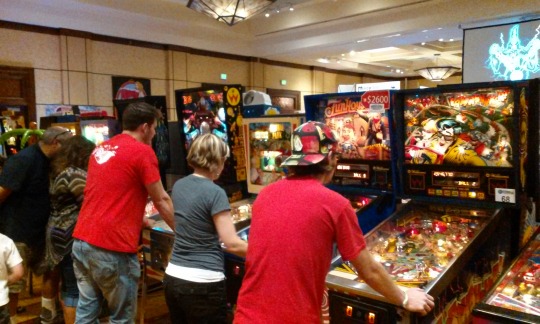
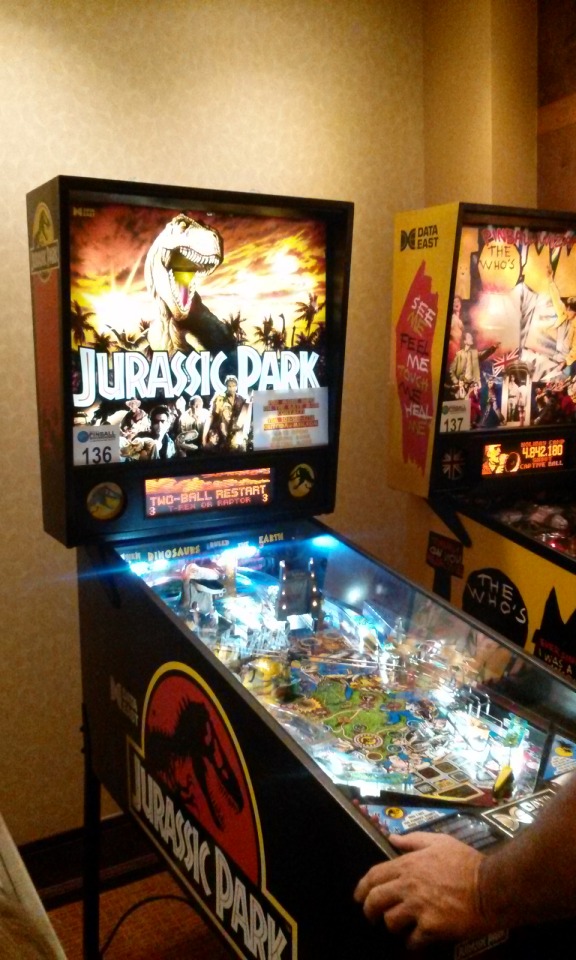
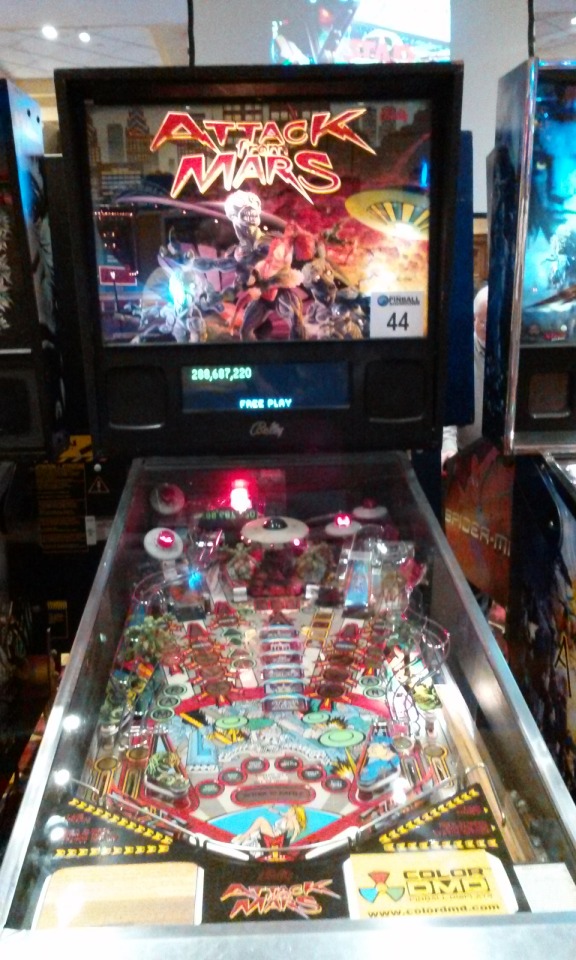
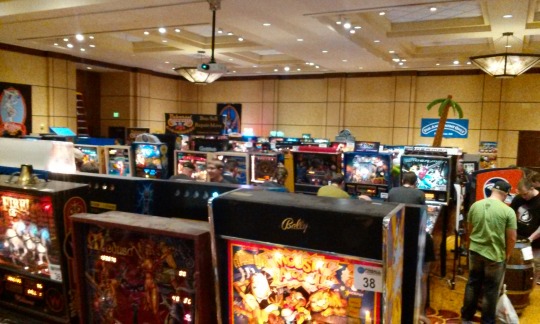
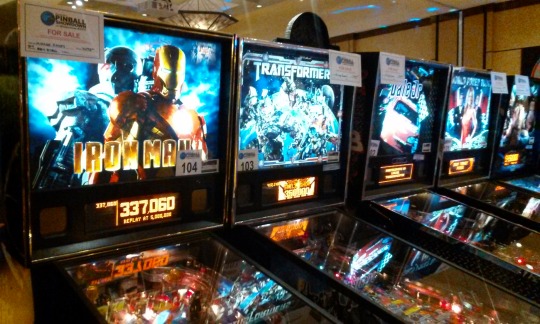



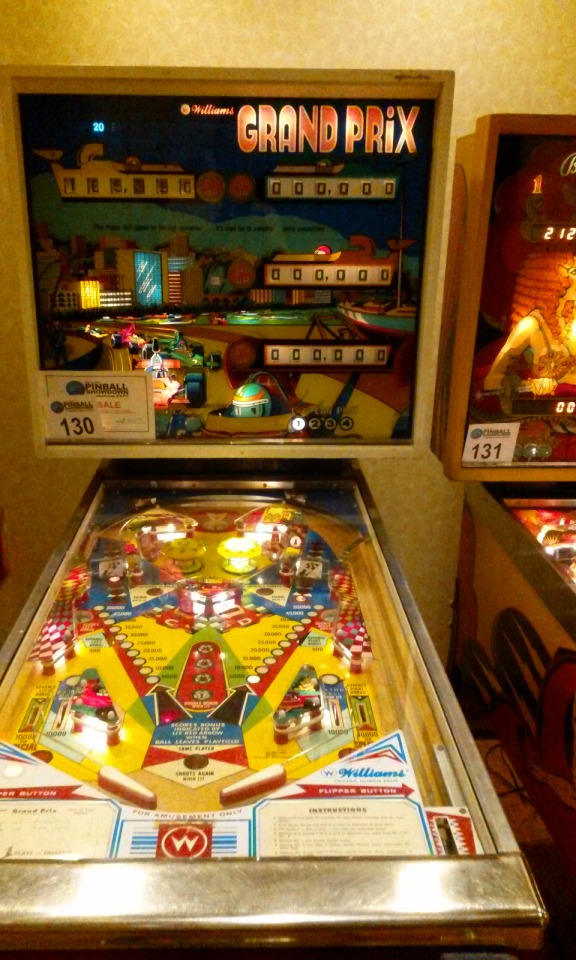
Rocky Mountain Pinball Showdown!
I am hesitant to bring more attention to this awesome event, as it seems to be just the right size as it is. Held in a hotel South of Denver, the showdown has more than 200 pinball tables all on free play. A great place to see some fantastic tables, and have fun too.
When I was in college, the student center had a T2 table, as well as a Whirlwind like the one you see here. Of course they had Street Fighter II as well, so a person went to the pinball machines if there was no opportunity to dominate as Zangief. This happened a lot.
Over the years I have come to like pinball more and more, mostly because I appreciate the crazy artwork and the engineering that went into the tables. The more modern machines are great, but I prefer the ones that even pre-date me with analog score counters. There is something about a transistor and relay based pinball machine that is very cool.
There is a local guy named Mark Gibson who has wired up a bunch of pinball parts as standalone circuits -- he brings a couple of tables worth the the Maker Faires in town and lets kids go to town. The little ones love it, and so does their dad.
Someday I’ll have an Attack From Mars table, just like someday I’ll have an original Donkey Kong machine. * sigh* it is good to wish.
0 notes